Happy New Year, The Citizen will return on Jan.





Christine HINZMANN Citizen staff chinzmann@pgcitizen.ca
“If we were to look at everything that’s happened over the last year, I think we’ve had a really busy, busy year, which seems to be the new normal for everyone,” Tim Bennett, School District 57 board chair, said.
“We have a lot we can be proud of, most recently the result which we’ve had with our graduation rates.”
There was a significant increase in students who graduated from the 2017-18 school year.
“There was an increase of 8.5 per cent in our Aboriginal graduation rate and an overall increase of 6.5 per cent and we saw movement and further growth in our special needs and ELL (English language learning) graduation rates,” Bennett said.
“We do like to celebrate the fact that we were able to see these significant jumps, recognizing that we still have a lot of work to do.” Indigenous graduation rates currently sit at 68 per cent. Bennett said there’s always room for improvement and SD 57 will continue to improve those number so the increase isn’t just a spike in a 10-year projection, he added.
“We’d rather have that be the new baseline from where we start to build,” said Bennett, who credits the increase to early interventions that have been available for the last few years. Efforts have also been focused on inclusion, putting emphasis on making sure Indigenous students feel they are part of the school’s community.
“We know that once they are engaged in the building, we know students will be coming to school on a regular basis, which will
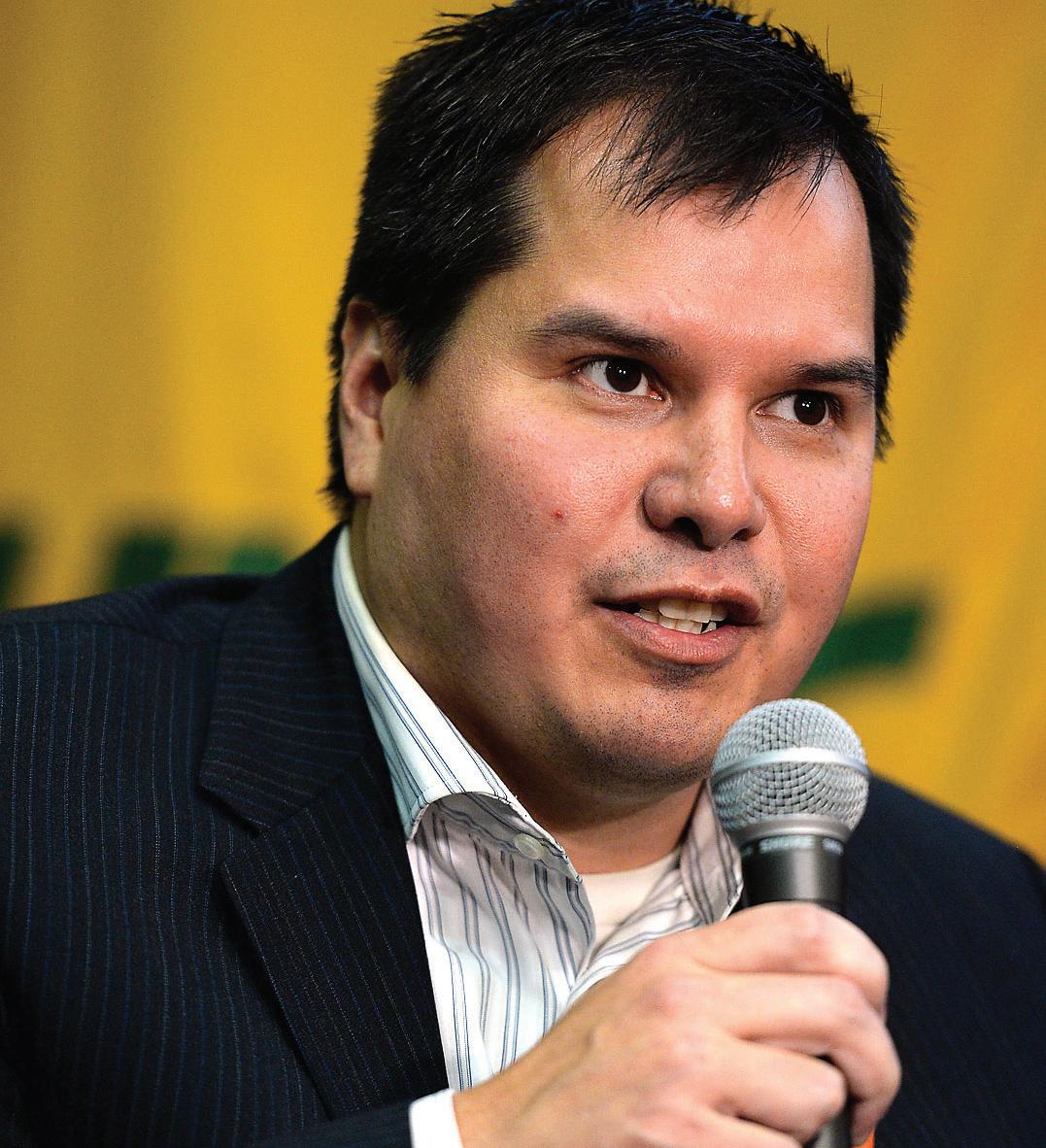
impact their overall academics,” Bennett said.
Another issue addressed in 2018 was low early literacy rates. There was a large percentage of Grade 2 students who were not reading at grade level.
“So the district invested time and money into early literacy intervention and within the first year has seen some significant results with early reading and that will remain a focus of the district as we head into 2019,”
Bennett said.
In 2018, the election of the board of trustees took place in October. Only weeks into it, the board is just getting situated.
“We’re getting everyone up to speed and setting the framework for what I think is really going to be an exciting four years for the new board, addressing challenges that I think are facing the public education sector including the new funding formula that will be coming out, the brand new Grade 11/12
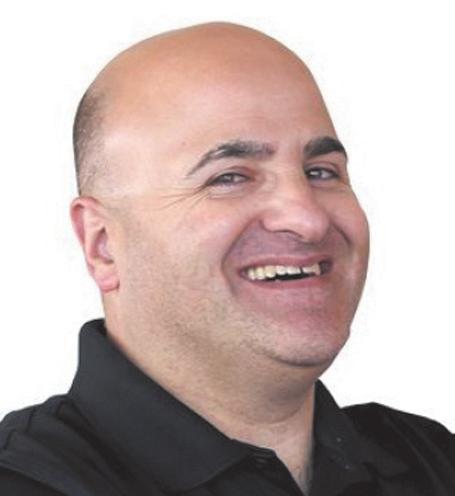
graduation program and ensuring that public education and the locally elected board remain relevant and continue to address the needs of our community,” Bennett said.
Trent Derrick is a new trustee on the School District 57 board and his platform during his campaign included increasing graduation rates, particularly for Indigenous students.
Derrick said he knows the 8.5 per cent increase in graduation numbers is a step in the right direction but more has to be done.
“I have a lot of ideas on how to improve the numbers but I’m pretty realistic and it’s all going to take time,” he said.
“I think there are a lot of challenges there and I think it’s important to focus on healthy lifestyles.”
Derrick said he believes the school board needs to reach out to community partners like Northern Health and the Ministry of Social Development to make significant
long-term changes in the health of students.
He also said as the new board gathered after the recent election he saw a lot of respect shown to one another and was quite impressed that even if people didn’t see eye to eye they still heard one another.
“I’m really enthused about this board,” Derrick said.
“There’s a lot of great ideas and I think we all have our strengths and we’re all pretty respectful of each other. I think that’s one of our greatest strengths. We have a group that’s willing to listen to each other, to the community and seek input.” Ron Polillo, who previously sat on the Catholic school board for six years, was also elected in October to the SD 57 board.
“For me there’s hardly anything more important than education,” Polillo said. “If you look at the provincial government budget the two top-spending items are health and education.”
One of the first things Polillo said he learned during his first month as a trustee is that the education system in B.C. is world class.
“It’s amongst the best education systems in the world and other areas – countries and provinces – are looking to B.C. to see what we’re doing so well.”
Capacity and classroom size are two pillars that were part of the foundation on which Polillo ran his campaign.
“Those are still going to be big issues that we’re going to deal with probably for the next four years,” Polillo said. “Student enrolment is increasing and our schools are getting full and we have to deal with that.”
Safe and inclusive schools are important, particularly when looking at the success of Indigenous students in the public school system, he added.
— see ‘WE LIVE, page 3
Frank PEEBLES Citizen staff fpeebles@pgcitizen.ca
Snowplows are pushing plumes, loaders are power-shoveling, and graders are wind-rowing the white stuff.
It is the first big dump of staying snow this winter and City of Prince George crews were ready for it.
“Snow and ice control crews are in full operation clearing priority routes throughout the city due to the ongoing heavy snowfall,” said city hall spokesman Michael Kellett.
He explained that the city is arranged into three categories. Prince George has

670 km of roads and 184 km of sidewalks. A colour-coded breakdown of the three categories (orange/pink is Priority 1, green is Priority 2, grey is Priority 3 and the thick yellow routes are provincial jurisdiction) can be seen online at the City of Prince George website under the keyword title Snow Removal Priority Rating.
“Graders and loaders are clearing priority one and priority two routes while sander/plow trucks and sidewalk machines are also operating on routes around the city,” said Kellett. “Snow and ice control crews will remain in full operation 24 hours per day through the weekend clearing priority routes throughout the city, including the downtown area.”
Kellett explained the thresholds for different snow-clearing actions to be taken by municipal crews.
• If at least 7.5 cm of snow falls in a 24hour period, the city aims to clear Priority 1 and Priority 2 routes 48 hours following the end of the snowfall.
• If at least 12 cm of snow falls in a 24hour period, as it did Friday, the city aims to clear Priority 3 routes 72 hours after Priority 1 and 2 routes are completed.
To aid in the snow clearing efforts, residents are reminded that winter parking laws are in effect from now until April 15.
• On-street parking is prohibited from
midnight to 7 a.m. downtown.
• On-street parking is prohibited from 10 p.m. to 7 a.m. on Priority 1 roads and hills, the hospital district, and a number of other designated roads.
• On-street parking is prohibited from 8 a.m. to 6 p.m. in residential areas. Parking on the side of the street with odd house numbers is permitted from 6 p.m. to 8 a.m. unless otherwise posted. Illegally parked vehicles are subject to a $50 ticket per offence and/or may be towed. (Plowing around parked vehicles can slow down operations and create hazards for other vehicles by creating windrows in the street.)

Frank PEEBLES Citizen staff fpeebles@pgcitizen.ca
CN Centre was first called the Multiplex for a reason. It was constructed intentionally to be much more than just the home rink of the Prince George Cougars hockey club. The Cougars are still the primary tenant for the building, drawing tens of thousands of bums to CN Centre seats per season, but it is indeed a full-spectrum facility. It provides a home to trade shows, concerts, conventions, theatre events, and much more.
Apart from the Cougars games, the minor hockey ice times, and the recreational hockey leagues that use the place (in addition to figure skating, ringette and other ice sports), here is what CN Centre brought to town in 2018.
Feb. 8 – local rock guitarist Dave Rosin got to come back to Prince George with his band Hedley. Lead singer Jake Hoggard’s behaviour had embroiled the band in controversy about then, and the band went on hiatus soon after the P.G. date.
Feb. 24 – Beer Bacon and Bands. “This was very successful and saw a full floor of guests enjoying local food and beer while being entertained with live music,” said CN Centre’s event manager Tracy Shaw. Mar. 8 – Johnny Reid “played an almost full house” along with Glass Tiger and Jessica Mitchell.
Apr. 17 – The Broadway presentation of The Illusionists “came for the first time playing to a packed house.”
April 25-29 – Cirque du Soleil’s Crystal “performed to enthusiastic crowds,” said Shaw. “This was a ground breaking event

CITIZEN FILE PHOTO
Glen Mikkelsen from CN Centre and Andy Beesley from the Prince George Cougars introduced their inflatable arm flailing tube man, or air dancer, for short – to help tell people that it is Event Day at CN Centre on Nov. 23.
combining both acrobatics and ice skating. P.G. was one of the earliest selected cities to perform based on Cirque’s Dralion attendance in 2015.”
May 6 – Dirty Dancing, the live musical theatre version of the popular movie.
May 11-13 – Northern FanCon, an innovative and unique tourist draw and local favourite for fans of pop-culture.
May 17 – “Seinfeld played to an almost sold out crowd,” said Shaw.
June 16-17 – For the first time, the 24Hour Relay For Life supporting the Canadian Cancer Society was moved to Exhibi-
tion Park. CN Centre officials considered it a “successful” transplantation of an iconic local charity event.
July 13-15 – Watchtower Convention.
July 19-29 – Circo Osorio Circus set up their purple pavilion in the outer parking lot.
Aug. 10-12 – First-ever Cariboo Rocks the North classic rock festival, which was so successful it was announced on the spot that another would be held in 2019.
Aug. 16-19 – A northern tradition, the BCNE, once again entertained the region while celebrating the local agriculture industry and local history.
Oct. 13 – Figure skating royalty came on the Thank You Canada Ice Skating Tour, featuring Canadian Olympic stars Meagan Duhamel and Eric Radford, Kaetlyn Osmond, Kaitlyn Weaver and Andrew Poje, Patrick Chan, legend Elvis Stojko, and superstar headliners Tessa Virtue and Scott Moir.
Nov. 4 – John Mellencamp made his return to P.G. on the Sad Clowns & Hillbillies tour.
Nov. 5 – Canada’s top-grossing standup comedian, one of the most popular comedians in the world, Russell Peters, made his P.G. debut with opening act Jake Johannsen. It was close to sold out.
Nov. 9 – Alt-country legends Nitty Gritty Dirt Band came back to P.G. after years apart, and they brought along fast-rising Canadian supporting act Nice Horse.
Nov. 29 – Country rocker Tim Hicks brought his Get Loud tour to P.G. along with special support acts Tebey and Andrew Hyatt and featured duet act Alee Adamoski. Dec. 15 – The combination of acrobatics and winter storyland scenes made for Cirque Musica’s Wonderland, which featured a large orchestra of local musicians joining the performance.
“2019 is shaping up to be just as busy with Stomp, FMX Motocross, Kinky Boots, Rock of Ages, Colin James and Judas Priest, along with our annual favourites such as FanCon, Cariboo Rocks the North, Cancer Relay and the BCNE,” Shaw said. “And these are just what’s been announced so far.”
Fifteen Cougars home games also remain, plus whatever the fans and players can generate if they crack into the playoffs.

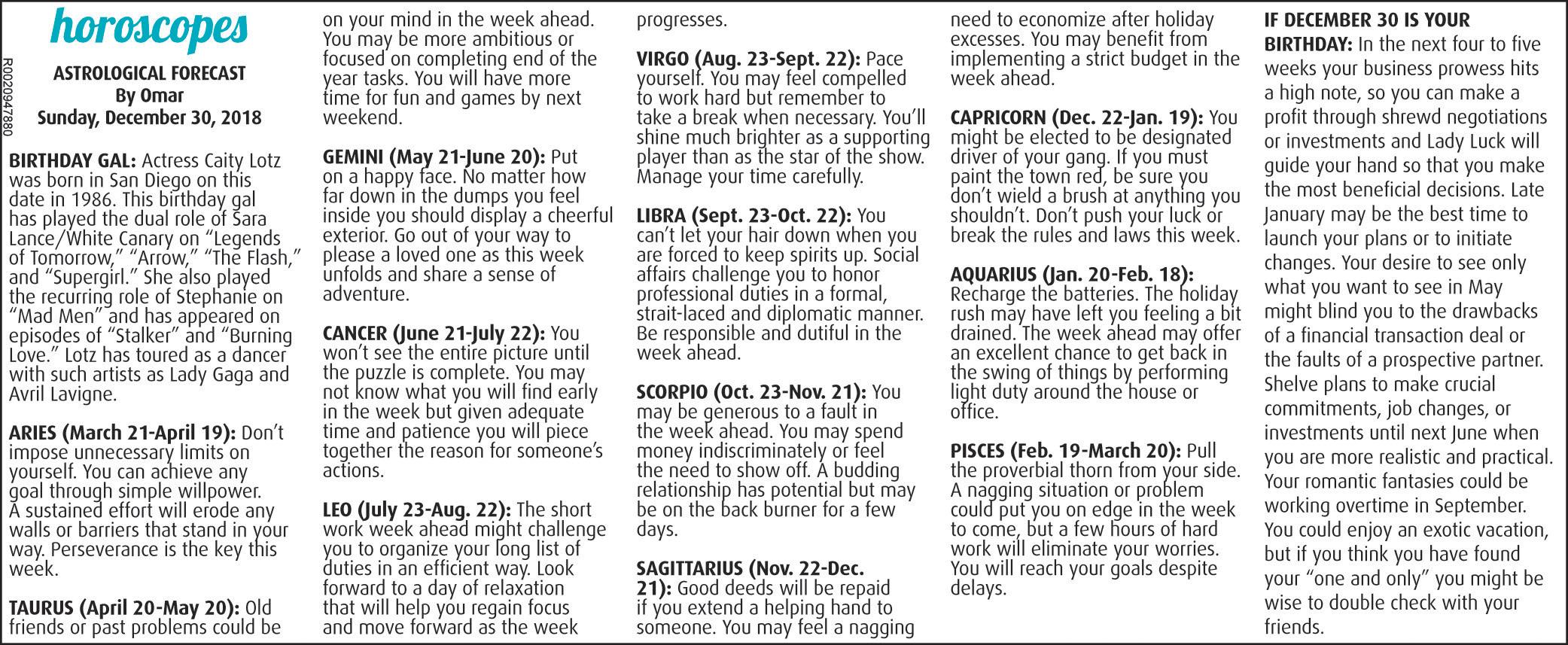


Mark NIELSEN Citizen staff
mnielsen@pgcitizen.ca
Perhaps the biggest case to pass through the Prince George courthouse in 2018 ended with three men sentenced to lengthy terms behind bars for the shooting death of Jordan Taylor McLeod.
Each of Darren Cayley Daniel Sundman and Sebastian Blake Martin were found guilty of second-degree murder and respectively sentenced to 16 and 13 years without eligibility to apply for parole while Kurtis Riley Sundman was sentenced to a further seven years seven months and 15 days for manslaughter.
A judge found McLeod was shot to death on Upper Fraser Road and his body dumped off a forest service road west of the city.
A mid-level drug dealer, McLeod, who was 24 at the time of his death, had been supplying product to the Sundmans to sell in the Vanderhoof area.
But in an apparent falling out with the brothers, he started supplying another man, Tanner James, while also striking up a relationship with Darren Sundman’s exgirlfriend, Stacey Stevenson.
The trouble reached a boiling point when McLeod found himself in a pickup truck with the brothers, Martin and Stevenson.
All three of McLeod’s assailants were high on drugs, ranging from methamphetamine in the cases of the Sundmans to a “speedball” of heroin and cocaine for that of Martin.
For reasons not entirely clear, the mood turned ugly with Darren Sundman hitting McLeod in the head with the butt of his gun as he sat behind him. With Kurtis Sundman behind the wheel, they passed through Prince George and sped along Highway 16, telling McLeod he had no choice but to jump out of the truck.
When Kurtis Sundman turned onto Upper Fraser Road and slowed down as a consequence, McLeod did jump out. The truck was pulled over and the three went after McLeod. Stevenson, who remained in the vehicle, became a key witness at the trial.
The sentences were issued in July following a lengthy trial.
Drug-related gunplay was also a theme in a trial for two men and a woman convicted of driving to Mackenzie in a stolen vehicle and opening fire on two men as they stood in a front yard. One of them suffered a wound to his calf.
For that July 7, 2016 incident, Kelly Michael Richet was sentenced to a further four years and five months in prison, Christopher Ryan Russell was sentenced to a further three years and 11 months, both terms
issued in July, and Miranda Leigh Dingwall was sentenced in June to slightly more than two more years.
In August, Robyn Glenn Derksen was sentenced to a further seven years and nine months for luring a woman into his home on the night of Oct. 4, 2015 with the intent of murdering her. She managed to escape, but not before she had a serious scare.
Derksen later told police he had a “demon in him that came out when he was drunk,” and had been looking for a victim to murder for as much as two years, oftentimes carrying around a box cutter as he roamed the city.
He pleaded guilty to attempted murder following a preliminary inquiry.
In September, a father and son were sentenced for luring a woman to a forest service road east of the city and then attacking her with a machete.
James Stanley Filiatrault was sentenced to nine years and son William Thomas Filiatrault was sentenced to seven years for the Nov. 5, 2016 incident.
And in November, Jeff John Lapier was sentenced to a further 23 months in jail for pulling the trigger on a woman who was to be a key witness at a trial after luring her to Moore’s Meadow on Feb. 15, 2016. Lapier had been sentenced to six years in total but received credit of four years and one month
for time served prior to sentencing.
Looking ahead to 2019, a case for four men accused of a drug-related double murder has reached the pre-trial stage.
Each of Seaver Tye Miller, Aaron Ryan Moore, Joshua Steven West and Perry Andrew Charlie are accused of first-degree murder in the shooting deaths of Thomas Burt Reed, 51, of Burns Lake and David Laurin Franks, 46, of Prince George and the attempted murder of a third man, all found Jan. 26, 2017 in a car off the side of Foothills Boulevard near North Nechako Road.
As well, a trial is set for January for Thomas Joshua Toman and Julien Naseem Abdala Yasin Lazarre, each charged with attempted murder with a firearm from an alleged Dec. 16, 2017 home invasion in the VLA.
In December, a charge of attempted murder against Michael Campbell-Alexander was stayed. He pleaded guilty to discharging a firearm with intent to wound and killing an animal from an Oct. 22, 2017 shootout at a 200-block Tamarack Street drug house. He will be sentenced once a pre-sentence report has been completed.
In November, Cody Aubrey Lornsten was sentenced to a further 2 1/2 years in prison for wielding a prohibited firearm – a sawed off shotgun – from the incident.
— from page 1
Polillo acknowledged the improvement of the percentages of students graduating and looks at the big picture.
“We’ve still got a lot of work to do but what I’d like to see is why can’t Prince George be a leader in the province?” Polillo challenged.
“With graduation rates and other aspects as well.”
Bottom line for Polillo is student success and doing everything possible to make sure that happens.
‘We live in a very different world now’ It’s about finding ways to continue to improve and adapt to some of these new realities that are being faced by our schools and our students every day.
For students, the age of technology and social media can be hard to navigate, Bennett said.
“I think we live in a very different world now where we’re dealing with online threats, our students are dealing with new and different pressures every day,” he added.
In late 2018, two College Heights Secondary School students committed suicide in a span of about two weeks, while other students were lost to accidents. It’s been a tough year.
“So the question is how we come together to support our students,” Bennett said.
“Ensuring the safety of all of our students is our number one priority. We’ve brought together all our community stakeholders whether it is around violent threat risk assessment or whether it’s our critical incident response team, working with our partners, reviewing our current practices, making recommendations. It’s about finding ways to continue to improve and adapt to some of these new realities that are being faced by our schools and our students every day.”
Looking to 2019, the most exciting and challenging thing, Bennett said, is the continued growth SD 57 is experiencing.
“We’re going to be doing a lot of work in terms of looking at how we can best meet the space needs of our district,” Bennett said.
“So right now we are sitting just over 13,000 students, which is about 1,200 more than the projections from 2014. We are facing some space needs in many areas in town so it’s going to be the work
— Tim Bennett, SD57 chairperson
of the board of the district to look at how we can best meet the needs of our current students and future students because projections say our school district numbers will most likely continue to grow.”
The progress being made on the construction of the new Kelly Road Secondary School is very exciting, Bennett said.
“We are still set to welcome students into the new school in September of 2020,” he said. The mild winter has helped continue construction of the building. Bennett has been on a virtual tour of the school and said there are similarities to the new Duchess Park Secondary School.
The ministry of education will only authorize the size of a new school according to the current numbers of students enrolled but that’s not ideal looking at the increase of student enrollment numbers in the future.
The original rebuild was going to be able to accommodate 700 students and the SD 57 board was able to secure the build to accommodate 900 students who live north of the Nechako River, Bennett said.
“So we were able to do that through some negotiations with the ministry and through a commitment from the district,” Bennett said.
“It’s going to be a beautiful school. It’s something the district and that neighbourhood can be very proud of.”

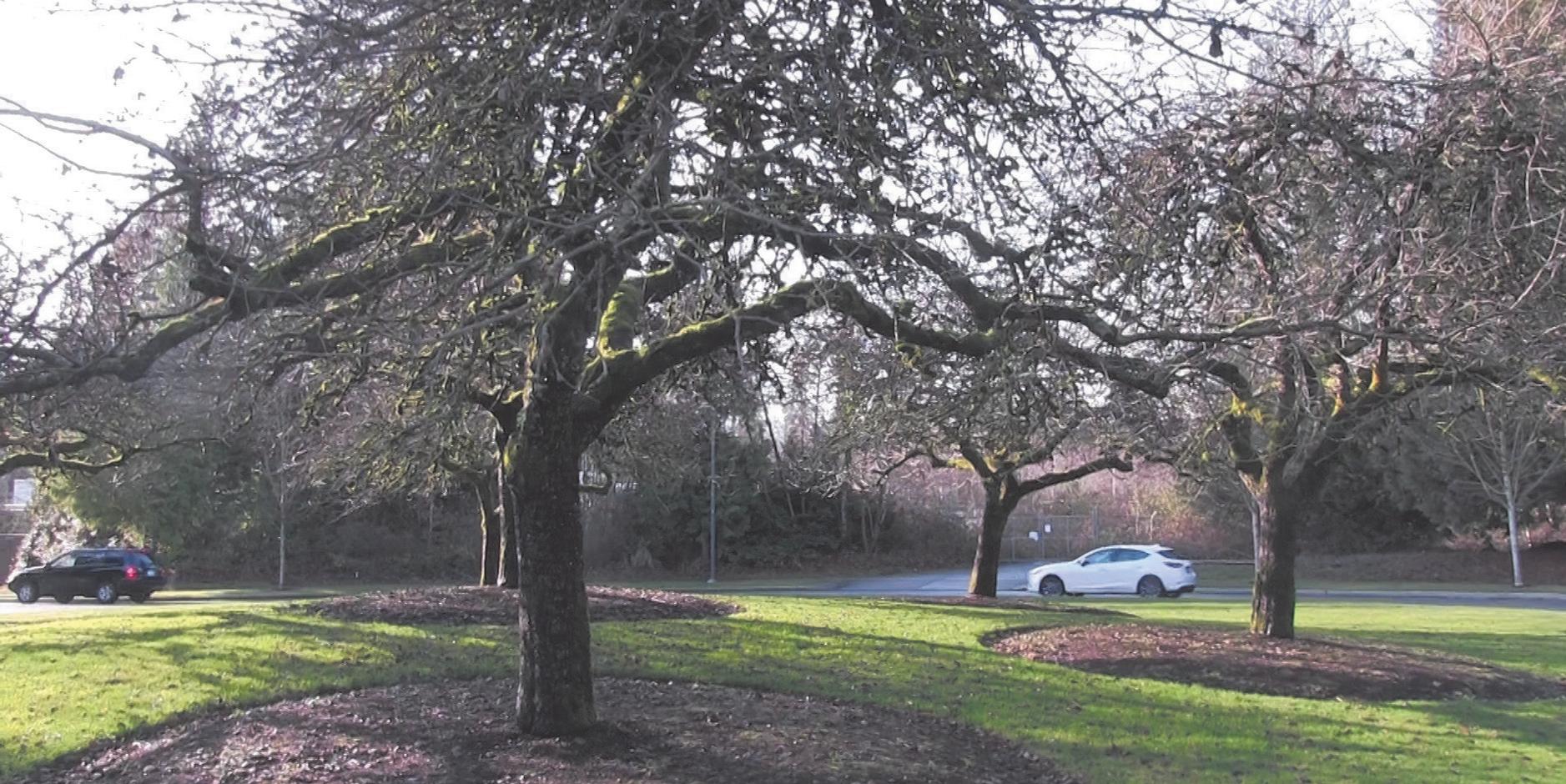
On a cold, sunny day in December, Jean-Michel Poutissou paused to admire the six apple trees that he once fought to save.
Poutissou came to Vancouver in October 1972 when the trees on the campus of physics laboratory TRIUMF were mere saplings. The trees are scions of the same tree that Sir Isaac Newton is said to have sat under as he pondered gravity.
Poutissou, a researcher emeritus at TRIUMF, said the trees “were happily growing” until the mid-1990s when condo developers wanted a straight road from the campus to the homes. The trees were in danger of being axed.
“Nobody (involved in the development) cared too much about Newton apple trees,” he said. “For them, they were in the way.” It took a campaign to convince the president of the University of British Columbia, where TRIUMF is located, to intervene and save the roundabout where the trees are planted, he said.
Now nearly 50 years old, the trees are covered in buds that will fatten over the winter before bursting into fruit.
Poutissou said he’s tasted the apples but that was a long time ago and he doesn’t remember their exact flavour.
“It’s not quite unlike a McIntosh but don’t hold me to that,” he said with a laugh.
The trees’ journey began sometime in the late 1960s and early 1970s.
Letters between the University of British Columbia and the National Physical Laboratory in Teddington, England, show that on the day two grafts of the trees arrived in Vancouver on an Air Canada flight on Jan. 4, 1971, the ground was covered in

more than 50 centimetres of snow.
The two cuttings were further grafted and now six trees sit on the TRIUMF campus.
Today, the National Trust in the U.K. is the custodian of the original apple tree at Woolsthorpe Manor, where Newton considered the laws of gravity. The tree is called Flower of Kent, a traditional variety, which produces cooking apples of varying sizes.
An email from the organization says there are many universities around the world that have twins of the original tree. It’s not known how the idea to send universities Newton’s apple trees came about and there doesn’t seem to be a tradition or policy, it says.
“It’s likely this was spread more by word of mouth between universities.”
The tree is an icon of learning, discovery and the start of the era of modern science,
the trust says.
In 1820, a storm blew over the original tree, but it survived and continued to grow new roots, the organization says.
Seeds from its descendants have also defied gravity and made a trip to space, thanks to Robert Prince, professor emeritus of the Lassonde School of Engineering at York University in Toronto.
Astronaut Steve MacLean was Prince’s student. He was assigned to a space flight in 2006 and his former teacher had a task for him. He wanted MacLean to take a picture of an apple floating over his head.
“I had this idea of doing something rather humorous with this apple over his head and staying and not falling like Newton’s theory of microgravity,” Price said.
When MacLean told Prince he wasn’t allowed to take fresh fruit because of contam-
ination, the seeds were sent up instead.
Prince said the seeds are now in the possession of the physics department at York University.
“They may go on display at some point along with other MacLean’s artifacts.”
The trees on York’s campus were planted in 1999. Originally three trees were planted but some didn’t survive because of the climate, while others were damaged. Only one took root.
“It survived and bore fruit quickly,” Prince said. “I was surprised at how quickly we got fruit off it.”
The apples are not very big.
“Like a crabapple size,” he added.
There has also been an imposter of the Newton apple tree in Canada.
Two Newton apple trees at the National Research Council in Ottawa were thought to be grafts from the original tree that were sent over in the 1960s, but it was determined they were unrelated to the tree Newton sat under. The tree was a Newton’s apple, but a different variety of the fruit. Dick Bourgeois-Doyle, who exposed the imposter trees while working on a book for the council’s centennial celebrations in 2016, says he felt guilty uncovering it.
His plan for a limited-edition coffee table book was going to include a memento from the apple tree: a leaf or a seed.
Newton probably wasn’t clunked on the head with an apple but the tree is still a touchstone linked to a significant point in scientific history, Bourgeois-Doyle said. Newton’s trees combine history, science, folklore and legend, which makes them enchanting, he said.
“If you can hold something in your hand or touch or look at something and that has a thread going back to Woolsthorpe Manor, it has a little bit of magic to it.”


watch the launch of the
to the International Space
David REEVELY Citizen news service
OTTAWA — The Canadian Space Agency says it wants to hire former astronaut Robert Thirsk to help it figure out how to contribute medical expertise to a human mission to Mars.
Thirsk is a medical doctor who holds the Canadian record for time spent in space, thanks to an extended mission on the International Space Station in 2009. Those are two of the qualifications the space agency considers essential for the $94,500 contract it made public Friday, saying Thirsk is the only person on Earth who fits the bill.
“As such, Dr. Thirsk is uniquely positioned to provide the CSA with the perspective of a crewmember and medical officer with regards to health and performance requirements during long-duration flights, as well as the associated capabilities to meet these requirements,” the space agency said in a public posting Friday.
It issued an “advance contract award notice,” essentially an open call for anyone who thinks they can meet the agency’s needs better than Thirsk to speak up.
As those needs are defined in the posting, nobody could.
Former astronaut Roberta Bondar is a physician, but she spent eight days in space to Thirsk’s almost 205. Dave Williams is a doctor who led NASA’s space and life-sciences directorate and did a stint in charge of space crews’ health and safety, but his two missions added up to 28 days in space.
Chris Hadfield, probably Canada’s most famous astronaut, spent 166 days in space on two shuttle missions and a long stay on the International Space Station – but he’s a pilot, not a doctor.
Another noteworthy Canadian astronaut, Julie Payette, is otherwise engaged for the next two years as Governor General, while Marc Garneau, currently federal transport minister, is looking to get re-elected to the House of Commons next fall.
Even if either wanted the job, neither has the precise qualifications the agency is after.
The job involves spending the next two years determining what Canadian scientists and health experts can do to help astronauts beyond low Earth orbit, and sell the public on the benefits of investing in space-health science.
Thirsk would work with “the Canadian biomedical, health and performance communities so that space health care solutions contribute to the improvement of remote health care delivery on Earth, in addition to other terrestrial health care benefits,” the posting says.
Thirsk is also to work with NASA “to secure a critical and visible role in the area of astronaut health and performance.”
The first year of the contract is worth $45,000. A second optional year is worth $49,500.
Thirsk did not respond to a request to talk about the work Friday.
The United States is contemplating a mis-
As such, Dr. Thirsk is uniquely positioned to provide the CSA with the perspective of a crewmember and medical officer with regards to health and performance requirements during long-duration flights...
— Canadian Space Agency
sion to Mars, likely in the early 2030s when the two planets will be closest. NASA’s administrator recently visited Ottawa to solicit Canadian help for preliminary steps, including a platform to orbit the moon for a human mission there.
Long space missions degrade astronauts’ muscles and bones, expose them to hard radiation and can even damage their senses.
An astronaut who gets acutely ill or hurt in Earth orbit can be sent home fairly quickly; one who’s halfway to Mars can’t.
A voyage to Mars would take at least six months each way, long enough for serious problems to set in – especially if the astronauts making the trip want to arrive ready for physical work on the surface.
Thirsk led the agency’s expert panel that recommended work on minimizing these dangers should be how Canada helps the human race explore space, in a report that hasn’t been released yet.
Why are the qualifications for the contract so narrowly drawn?
“The contract in question is being put in place to further develop elements of the health-care vision outlined in the Expert Group Report (forthcoming) which incorporates the results of consultations with national and international experts,” Canadian Space Agency spokeswoman Arielle Mathieu said by email. “Dr. Robert Thirsk, former CSA astronaut, has been identified as having the unique qualifications, experience and availability to complete the work.
“Suppliers who consider themselves qualified may still submit a statement of capabilities for consideration, before Jan. 31, 2019.”
Thirsk called on the federal government to “restore adequate funding” to Canada’s space program “as a means to stretch our national capabilities and rally our citizens,” in a submission this fall to the House of Common’s finance committee.
The committee’s final report included a recommendation that the federal government commit in the 2019 budget to “significant, ongoing investments” in the space agency and to “contribute to space exploration and science.”
Vancouver police say so far they can’t corroborate child luring
Citizen news service
Vancouver police say they have been unable to corroborate a claim that a six-year-old girl was lured from the playground of an elementary school earlier this month.
Police say they have investigated tips from the public, interviewed staff and students at the school, spoken to neighbours and reviewed video footage but have found no evidence that it happened.
Sgt. Jason Robillard says the investigation is ongoing.
Police have been investigating an allegation that the girl was in the playground area outside Sexsmith Elementary School in south Vancouver on Dec. 5 when a man took her to a nearby location where he assaulted her, then returned her to school.
Robillard says detectives from the department’s sex crimes unit and youth services section con-
ducted the investigation. He says investigating allegations that affect personal safety, especially involving children, is a priority for police.
“We feel this is an important update for parents, staff, students and the broader community to be aware of,” he said.

Jordan PRESS Citizen news service
OTTAWA — Canada’s infrastructure minister says an overhaul of how the government approves funding for projects should solve concerns about construction delays and escalating costs. Internal documents show that federal officials have been told that the first chunk of the Liberals’ infrastructure program – $14.4 billion aimed at fixing roads, bridges, highways, transit and water systems – pushed up prices as demand for work outstripped the supply of companies available to do it in multiple parts of the country.
During a late-2017 meeting of federal, provincial and territorial infrastructure ministers, the provincial ministers noted some municipal projects were “way overbudget” – a problem because federal infrastructure programs don’t normally cover cost overruns after funding is approved.
(The Canadian Press obtained notes from the meeting under the Access to Information Act.)
In response, the government has agreed that for the rest of the winter, federal officials will sign off on plans so money and work are ready to roll come spring, which Infrastructure Minister Francois-Philippe Champagne says will finally align bureaucratic processes with Canada’s construction season.
“If you don’t give the answer at the right time in the calendar year, you might delay a project by 18, 20 months,” Champagne said recently during a wide-ranging interview.
“It’s about doing things better and smarter,” he said, adding later: “I know that may sound very logical, but trust me, it might not always have been the case.”
The backroom change is one Champagne hopes will address public concerns that cities hold off work until they are sure the Liberals will chip in money, which also worsens cost overruns.
Champagne said a pilot project to run next year with Nova Scotia, Alberta and Saskatchewan will test making payments when projects hit particular milestones, as opposed to waiting to reimburse municipalities only after they submit receipts.
The idea, he said, is to see if milestone payments put government accounting “more in line with the impact and the percentage of completion.”
Under the Liberals, planned federal spending on new roads, bridges, highways, trains and water systems has risen
As 2018 comes to a close, Champagne said there are some 4,400 projects worth $50 billion on the go, of which about $20 billion is from federal investments...
to $186 billion over 12 years. Provinces, territories and cities are expected to put up varying percentages of project costs, with municipalities paying the smallest share.
Champagne said there likely won’t be any change to lessen the share cities have to pay for projects, noting 10-year funding agreements with provinces have set the rules for the next decade.
As 2018 comes to a close, Champagne said there are some 4,400 projects worth $50 billion on the go, of which about $20 billion is from federal investments – a word the Quebec MP used often during the roundtable interview.
“I’ve banned the word ‘spend.’ I said, we don’t spend, we invest, because if you look at the outcomes we’re going to provide, those are all investments,” he said. “We need to move from numbers to impact.”
The government has been criticized for the slower-than-anticipated pace of infrastructure dollars leaving the federal treasury.
Previously, government officials have quietly suggested they weren’t too concerned about delays in some projects funded through the first tranche of the Liberals’ infrastructure program because voters would see work underway around election time next fall.
But the Liberals told the late 2017 meeting with provinces and territories that they were “getting pounded” by the opposition and media over the issue. They pressed lower levels of government to report on progress faster so federal officials could put those details out to the public. The documents also show concerns from Indigenous communities and territorial governments about the reporting requirements, which require project proponents to detail the jobs created by federal dollars.
Champagne said he has met with Assembly of First Nations to look at ways to ease reporting requirements for Indigenous communities.

Here are a few things about 2018 that made me happy. Happy New Year, everyone!
Music
• PGSO clears its debt
• Cariboo Rocks The North
• Jann Arden
• Kendrick Lamar
• Greta Van Fleet
• Drake
• A Perfect Circle
• Smashing Pumpkins
• Twenty One Pilots
Stage
• Cabaret
• Legally Blonde
• Hedda Noir
•Million Dollar Quartet
Sports
• Prince George Spruce Kings playoff run
• Brett Connolly Stanley Cup win
• Vasiliki Louka/Maria Mongomo/Madison Landry – UNBC Timberwolves
• Philadelphia Eagles beating the New England Patriots to win the Super Bowl
• Seattle Seahawks making the playoffs after opening 0-2
• Sedin twins retire in style – score OT winner in final home game
• Elias Pettersson/Brock Boeser
• Serena Williams • Colin Kaepernick
Books
• Seven Fallen Feathers – Tanya Talaga
• On Tyranny – Timothy Snyder
• Time Travel: A History – James Gleick
• The Quantum Labyrinth – Paul Halpern
• The Coddling of the American Mind –Greg Lukianoff and Jonathan Haidt
• How The Right Lost Its Mind – Charlie Sykes
• Everything Trump Touches Dies – Rick Wilson
• Trumpocracy – David Frum
• Unthinkable – Helen Thomson
• Mad Blood Stirring – Daemon Fairless
• The Subtle Art of Not Giving A F*ck –Mark Manson
• Skin In The Game – Nassim Nicholas Taleb
• World Without Mind – Franklin Foer
• Obama: An Intimate Portrait – Pete Souza
• Your Favorite Band Is Killing Me/Twilight of the Gods – Steven Hyden
Comics
• Monstress – Marjorie Liu/Sana Takeda
• Royal City – Jeff Lemire
• Black Panther – Ta-Nehisi Coates/various artists
• Southern Bastards – Jason Aaron/Jason Latour
• The Black Monday Murders – Jonathan
Hickman/Tomm Coker
• East of West – Jonathan Hickman/Nick Dragotta
• The Manhattan Projects – Jonathan Hickman/Nick Pitarra
• Paper Girls – Brian K. Vaughan/Cliff Chiang
• Saga – Brian K. Vaughan/Fiona Staples
• Sex Criminals – Matt Fraction/Chip Zdarsky
• Fatale – Ed Brubaker/Sean Phillips
• The Fade Out – Ed Brubaker/Sean Phillips
• Hip Hop Family Tree Vols. 1-4 – Ed Piskor
Movies
• A Quiet Place
• Get Out
• Black Panther
• Avengers: Infinity War
• Arrival
• Blade Runner 2049
• The Circus • Frontline
• Nova
• Riverdale
• Grace and Frankie
• American Horror Story: Apocalypse
• Springsteen On Broadway
“I live 40 km out of town and drive a

Today’s Citizen (Dec. 28) brings yet another outraged screed courtesy of J.J. McCullough. It’s important to hear differing points of view, but I do wish The Citizen could find writers who were more balanced.
Take today’s guest editorial: McCullough delivers an extended rant on new federal legislation that subjects third-party activity during Canadian elections to more stringent rules, with the goal of making such activities more transparent. McCullough casts this legislation as part of an ongoing attack on political discourse, as if Canada were in danger of becoming an authoritarian state with no political freedoms. But what’s the context?
Is there evidence of Canadian governments shutting down political parties? Attempting to disenfranchise voters as they do in the U.S.? Imprisoning opposi-
tion politicians? I think not. So if the legislation in question is not part of a malign campaign by the “political class” (whatever that is) to keep power for themselves, is there some other reason for the Liberals to have passed it?
Oh, right! Pretty much all Western democracies are under a sustained barrage by anti-democratic actors, primarily Russia.
Robert Mueller in the U.S. has provided extensive and compelling evidence for Russia’s role in undermining free speech and fair elections there.
Furthermore, the Liberals may have looked at the electoral chaos sown by the U.S. Supreme Court’s Citizens United decision that allowed unlimited third-party spending in U.S. elections. This has led to a ridiculous and wasteful advertising race, in which even local elections may involve tens of millions of dollars in campaign spending. The only beneficiaries are the media outlets that carry the advertising.
Given the clear need to protect Canada from the political chaos afflicting our friends to the south,
why would McCullough bash this legislation without mentioning the context?
Well, one obvious possibility is that he could be on the take from the Russians. This would fall well within their playbook, to funnel cash or divisive ideas to unwitting (or witting!) agitators, who are only too happy to sow division and discord for their own benefit.
One need only look at all of the American dupes – like the guy who made his truck into a “jail” for Hillary Clinton and staged a protest rally; or the fool who believed Hillary was running a pedophilia ring out of a pizza restaurant and rushed in with a rifle to liberate the child sex slaves – who were taken in by Russian agitprop to see that in fact the Liberals are quite right to be concerned about election interference from abroad.
Until there is actual evidence that this legislation is harming honest, Canadian political speech, I am grateful that the Liberals are trying to protect us from outside political interference.
Stephen Rader, Prince George
LETTERS WELCOME: The Prince George Citizen welcomes letters to the editor from our readers. Submissions should be sent by email to: letters@pgcitizen.ca. No attachments, please. They can also be faxed to 250-960-2766, or mailed to 201-1777 Third Ave., Prince George, B.C. V2L 3G7. Maximum length is 750 words and writers are limited to one submission every week. We will edit letters only to ensure clarity, good taste, for legal reasons, and occasionally for length. Although we will not include your address and telephone number in the paper, we need both for verification purposes. Unsigned or handwritten letters will not be published. The Prince George Citizen is a member of the National Newsmedia Council, which is an independent organization established to deal with acceptable journalistic practices and ethical behaviour. If you have concerns about editorial content, please contact Neil Godbout (ngodbout@pgcitizen. ca or 250-960-2759). If you are not satisfied with the response and wish to file a formal complaint, visit the web site at mediacouncil.ca or call toll-free 1-844-877-1163 for additional information.

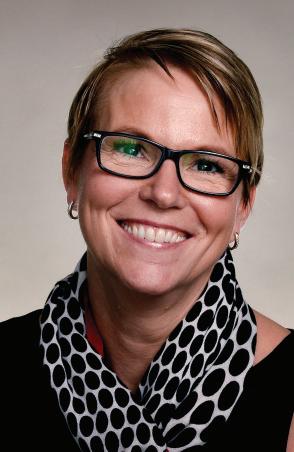


SHAWN CORNELL DIRECTOR OF ADVERTISING
diesel. What I find this akin to is asking PetroCan to build a gas station and give away fuel for free.”
– Regional District of Fraser-Fort George Area A Director Warren Wilson on spending $9,000 to help develop a plan to bring electric car charging stations to the Central Interior and Northern B.C.
“Please play it again, baby. Play it again in a loop.”
– CNN commentator Ana Navarro eating popcorn while reacting on CNN Tonight With Don Lemon to U.S. President Donald Trump’s meeting with Chuck Schumer and Nancy Pelosi in the Oval Office.
“This was my home, my safe place and where I was able to (make) my dreams come true. The ski hill lives but coming home this time won’t be the same without the same smelly lodge.”
– Prince George’s Meryeta O’Dine, a member of the national snowboard cross team and 2018 Winter Olympian, reacting to the news that the lodge at Tabor Mountain Resort had burned down.
“We had a beer and finished our breakfast.”
– Cariboo-Prince George MP Todd Doherty’s reaction while vacationing with his family in Hawaii in January, when everyone in the state received an emergency text message on their cellphones that read, “BALLISTIC MISSILE THREAT INBOUND TO HAWAII. SEEK IMMEDIATE SHELTER. THIS IS NOT A DRILL.” — Editor-in-chief Neil Godbout
The outcome of the electoral reform referendum in British Columbia was announced last week with little fanfare, accompanied by a few statements from politicians. This was a different postal vote than the others the province has held in this century. The level of participation was satisfactory, but British Columbians who did not cast a ballot readily admit to being confused.
The Research Co. exit poll of British Columbians mirrored the results of the referendum, with 49 per cent of respondents reporting they voted for the first-past-thepost system, 31 per cent voting to move to a proportional representation system, and 20 per cent not casting a ballot. Once the non-voters are removed, the result of the exit poll is 61 per cent choosing to retain the existing system and 39 per cent opting to change it.
The survey was designed to have a larger proportion of non-voters, in order to properly study why these citizens decided not to take part in the postal vote.
The No. 1 issue for those who chose not to vote is “not feeling informed enough” (48 per cent). While some non-voters also claimed they never received a ballot (18 per cent) or simply forgot to mail it (17 per cent), nothing came close to the uneasy feeling of being in the dark.
The notion of a process that would have done more to engage the more than half of British Columbians who chose not to exercise their right has been discussed prominently in the aftermath of the referendum. Some have openly questioned if the provincial government did all it could to inform residents, and whether a discussion devoid of politics would have made a difference in the minds of voters.
The exit poll suggests that the process was likely more to blame than the appetite of residents for a different system. When British Columbians are asked to imagine a different scenario, with a reform proposal that is guided by an independent citizens’ panel – not politicians – and would provide an option for proportional representation, 41 per cent of respondents would vote for change and 36 per cent would vote to keep first past the post.
With this different question, 15 per cent of British Columbians who voted for first past the post in the referendum would switch to support proportional representation. A further 15 per cent of these voters who endorsed the status quo would be undecided. Simply put, a less political and more
Mailing address: 201-1777 Third Ave. Prince George, B.C. V2L 3G7
Office hours: 9 a.m. to 5 p.m., Monday to Friday General switchboard: 250-562-2441 info@pgcitizen.ca General news: news@pgcitizen.ca Sports inquiries: 250-960-2764 sports@pgcitizen.ca
Classifieds advertising: 250-562-6666 cls@pgcitizen.ca
participatory process could move some voters who disliked the choices on their ballot.
The survey shows that large majorities of British Columbians support concepts such as attempting to eliminate “strategic voting” (75 per cent), having a system that does not disadvantage independent candidates (70 per cent) and a party not governing with a majority of seats but with fewer than 40 per cent of all votes cast (63 per cent). Still, more than half (52 per cent) also believe we should take no further steps at this time aimed at changing our electoral system. The concept of a legislature that is more representative of vote totals is popular. The way in which the decision was put to voters was not. I will offer some words of caution about what this all means for the future of our province. Reading the result of the referendum as a barometer of possible political allegiance in the next provincial election – whenever it may happen – is misguided.
The analysis goes like this: if you have a majority of voters in ridings held by the BC New Democratic Party (NDP) or the BC Green Party supporting first past the post, this means that the seats are in danger of going to the BC Liberals in the next election. This is simply not supported by data. While BC Liberal voters from 2017 were decidedly more likely to support first past the post (82 per cent), only 53 per cent of those who voted for the NDP and the Greens favoured proportional representation.
The numbers do not point to a disenchantment with all policies, simply a disagreement with one. Pick-your-poison elections – yes or no, in or out, remain or leave – are decidedly different from provincial ballots. If they were the same, the 2016 victory for the “Leave” side in Brexit would have led to the rebirth of the United Kingdom Independence Party (UKIP). In the first election following Brexit, UKIP finished with 1.8 per cent of all votes, down from its best showing of 12.6 per cent in 2015.
Our province has had experiences with this conundrum before. In 2011, many assumed that the defeat of the postal vote on whether to keep the harmonized sales tax (HST) in ridings that had voted for the BC Liberals signalled the demise of the ruling party.
— Mario Canseco is president of Research Co.
Shawn Cornell, director of advertising: 250-960-2757 scornell@pgcitizen.ca Reader sales and services: 250-562-3301 rss@pgcitizen.ca Letters to the editor: letters@pgcitizen.ca
Website: www.pgcitizen.ca Website feedback: digital@glaciermedia.ca
Member of the National Newsmedia Council A division of Glacier Media



Laura DAILY Citizen news service
Stuck at the airport? Ugh.
Whatever the reason – long layover, bad weather or an unexpected delay – and no matter how nice the terminal, you’re probably bored or tired. Wouldn’t it be lovely to have somewhere to escape the crowds, relax comfortably, charge your cellphone without battling for an electrical outlet and grab a bite that doesn’t take a chomp out of your wallet? Such a place exists: an airport lounge.
You don’t you need a membership, elite status, a first-class ticket or one of those fancy premium credit cards to gain entry. A number of lounges sell single-use day passes that are just the ticket for travellers with time to kill or in need of a quiet respite.
Once spartan spaces where harried frequent fliers could get a cup of coffee, make a phone call and read the newspaper, airport lounges have changed dramatically in the past decade, and are now nicely designed, comfortable spaces offering better food and worthwhile amenities.
“Airlines used to focus on the corporate traveler. Now across the industry, we’re seeing them invest in lounges to create a total experience for both the business and leisure traveller,” says Brett Catlin, managing director of alliances and product at Alaska Airlines, which is spending $40 million to build and renovate lounges across the United States. In addition to the U.S. airline-branded lounges, there are some operated independently, such as the Club Airport Lounge and Escape Lounge.
Want to enter the inner sanctum? Expect to pay $40 to $60 per person, typically at the door, for those operated by major U.S. carriers. (As of Nov. 15, Delta Air Lines discontinued the sale of single-visit passes to Delta Sky Clubs, and with the exception of Air Canada, Etihad Airways and Emirates, few international carriers sell day passes.)
You’ll be asked to show a governmentissued ID and a boarding pass for same-day travel on the airline or a partner airline. These spaces are capacity-controlled; you may be denied entry if it is crowded with card-carrying members and other passengers entitled to club use.
Once inside, travellers often receive access to complimentary eats, ample workspace with high-speed Internet, comfy spots to kick back, oodles of power outlets, private restrooms (where no one looks askance if you brush your teeth or change your clothes) and, in some lounges, a fully staffed travel desk.
That travel desk may be the most important. Airlines assign only their best-of-thebest gate agents to their lounges. So, if you miss a connection or your flight is cancelled, you have an experienced airline pro acting as a concierge who knows all the tricks to get you rebooked.
If you know in advance that you’ll have a long layover during your travels, you may want to check out programs such as LoungeBuddy or Lounge Pass, in addition to the airline you are flying. These websites offer access to hundreds of lounges globally.
Amenities and pricing vary by lounge –for example, some passes are only good for a few hours, or at limited times – and you may need to book at least 24 hours in advance, so read the fine print and plan accordingly.

Here are some lounge options as of Dec. 1:
Locations: Seven, including John F. Kennedy International Airport in New York City, Los Angeles International, Portland International and Seattle-Tacoma International.
Day pass: $50.
Amenities: Food and snacks, beverages (including wine and beer), TVs, high-speed WiFi, online access to newspapers, concierge service stations to help with lastminute upgrades.
On the menu: Steel-cut oatmeal, scones, bagels, a salad bar with artisanal breads, soups, veggies, hummus. Custom-crafted cocktails. Additional menu with freshmade entrees such as a Korean rice bowl or chicken pesto panini for $8 to $10.
Little extras: Starbucks coffee prepared by professional baristas in some locations (JFK now, Seattle soon). Wide selection of local microbrews – 12 on tap at the Seattle location.
If you love it: Purchase a membership within 30 days of purchasing a day pass and Alaska Airlines will refund the cost of the day pass.
Locations: 50+
Day pass: $59 (not available in Charlotte International, Pittsburgh International, Boston’s Logan International and Dallas-Fort Worth International because of construction that has limited seating).
Amenities: Lounge-style seating, highspeed WiFi, personal travel assistance,
snacks and beverages, shower suites and business centers.
On the menu: Breakfast might include hard-boiled eggs, oatmeal and cereal, fruit, yogurt, bagels. The afternoon finds hearty soups, fresh salads, vegetables, hummus and cheese. Some clubs offer full meals for sale as well as premium cocktails.
Little extras: Fresh-brewed La Colombe coffee. Day-pass holders can bring up to three children under 18 with them.
Locations: More than 45 in 31 airports worldwide.
Day pass: $59.
Amenities: Beverages and light snacks, bar service, high-speed WiFi, agent assistance with reservations, seat assignments and electronic ticketing.
On the menu: Pastries, bagels, salad bar, soups, fresh vegetables with dip. Larger lounges offer full breakfast, lunch and dinner buffets.
Little extras: Free use of colour printers. Private “phone booths” with speakerphones at some locations.
If you love it: Purchase a membership within 30 days of purchasing a day pass and United will waive your initiation fee.
Locations: Honolulu’s Daniel K. Inouye International Airport Day pass: $40.
Amenities: Food and snacks, beverages (including wine and beer), high-speed WiFi, USB charging stations.
On the menu: Limited buffet for breakfast, lunch and dinner. Pastries by La Tour Cafe. Craft beer from Maui Brewing Co.
Little extras: Wines selected by a master sommelier.
Locations: In the United States at Atlanta Hartsfield-Jackson; Boston; BaltimoreWashington International Marshall; Cincinnati/Northern Kentucky International; Dallas-Fort Worth; Las Vegas’s McCarran International; Orlando International; Phoenix Sky Harbor International; Pittsburgh; Seattle; and San Jose International airports. In Britain at London’s Gatwick and Heathrow airports. Day pass: $40.
Amenities: Snacks, bottled water, soft drinks and alcoholic beverages, (including beer, wine and liquor), free WiFi, charging ports, TV and workstations with desktop PCs. Some locations offer shower facilities.
Little extras: Unlike other airline lounges, the Club allows guests to get food from an airport restaurant and bring it in with you.
Locations: Minneapolis-St. Paul International; Oakland International; Connecticut’s Bradley International; Reno-Tahoe International; Greenville-Spartanburg International (S.C.); and Ontario (Calif.) International airports.
Day pass: $40 if you pre-purchase, $45 for walk-ups. Amenities: Plenty of seating, quiet library area, full bar, business space, high-speed WiFi. On the menu: Food and beverage menu with complimentary lighter fare including cereals and pastries at breakfast, and sandwiches, salads and soups the rest of the day. You can also order heartier dishes from an extensive menu for an additional cost.
LAS VEGAS — No other city does New Year’s Eve like Las Vegas.
Lady Gaga, Bruno Mars and Gwen Stefani are among the superstars who will be ushering in the new year with performances at venues on the Las Vegas Strip, while more than 300,000 people are expected to gather on the world-famous corridor Monday to watch eight minutes of fireworks.
At another celebration in the downtown Fremont Street entertainment district, 12 bands will play under a massive video canopy that will show the ball drop in New York’s Time Square.
“The only thing that can top Las Vegas is Las Vegas on New Year’s Eve,” said Jacqueline Peterson of the Las Vegas Convention and Visitors Authority.
“The city continues to evolve itself. We never run out of things to do.”
Gaga’s New Year’s Eve concert at Park Theater at Park MGM casino-resort will be the third of her long-anticipated residency, which will debut Friday. Veteran Las Vegas performer Celine Dion will be at The Colosseum at Caesars Palace, and Maroon 5 will celebrate the holiday once again at the Mandalay Bay Events Center.

AP FILE PHOTO
People watch the fountains at the Bellagio while wearing paper hats to celebrate New Years Eve in Las Vegas in 2015.
Stefani will take the stage at Zappos Theater at Planet Hollywood casino-resort as part of the residency she kicked off this year. Calvin Harris, The Chainsmokers and J. Cole are among those performing at nightclubs.
While Las Vegas is known as a place for
last-minute trips, tourists who want to ring in 2019 here should act fast. Tourism officials expect 318,000 people to travel to Sin City for the holiday and nearly all the city’s more than 147,000 hotel rooms to be booked.
“Now is the time to do it,” Chris Baldizan,
senior vice-president of entertainment booking and development at MGM Resorts International, said about booking a trip for the holiday. But “we’ll always find a spot for somebody.”
New Year’s Eve is worth an estimated $403 million to Las Vegas, according to the convention and visitors authority, which is responsible for promoting the destination. In addition to concerts with tickets on sale for the general public, casino operators also host over-the-top private parties for their VIP guests. Caesars Entertainment hosted nine of those last year, which included DJs, dancers, fireworks shows, thousands of bottles of champagne and performances by Katy Perry, Jennifer Lopez and other stars. Five hangover brunches were served the next morning. Unlike the two previous years, New Year’s Eve falls on a weekday. Casino operators say the Monday celebration is a positive because it gives people a reason to stay beyond a typical weekend trip.
“It just means that more of our guests are coming in even earlier to spend more days celebrating in this great tradition,” said Chris Holdren, executive vice-president and chief marketing officer for Caesars Entertainment. “So, they may come in, spend the weekend and extend it to encompass the great holiday.”

Subscribe
Jason PETERS Citizen Sports Editor jpeters@pgcitizen.ca

For the second consecutive game at the Mac’s AAA Midget Hockey Tournament, the Cariboo Cougars got a glittering performance from their starting goaltender. Thanks to the Friday efforts of Xavier Cannon, the Cats pulled out a 4-3 win against the Brampton 45’s and have themselves in good position to vie for a playoff spot at the prestigious event. At the Max Bell Centre in Calgary, the 17-year-old Cannon faced 43 Brampton shots and stopped 40 of them. The Cougars were outshot 15-3 in a scoreless first period but, with Cannon standing tall, were able to find their legs in the second, a stretch of the game in which they outscored Brampton 4-2. The 45’s generated the only goal of the third but that’s as close as they got. The Cougars opened the scoring early in the second period, the goal by defenceman
Max Arnold. The 45’s got a power-play marker from Ethan Barnes about six minutes later but the Cougars responded quickly with goals by Alex Ochitwa and John Herrington and had themselves a 3-1 lead. Brampton – on another strike from Barnes, this time shorthanded – got back within one with 3:45 left to play in the period. At that point, the 45’s could have seized some momentum but Grady Thomas scored a key goal for the Cougars with 36 seconds left on the clock.
Aidan Gromek of the 45’s was the lone marksman in the third period.
Ochitwa had an assist to go along with his goal, while Brennan Bott – chosen the game star for the Cougars – chipped in with two helpers.
Noah Granata took the loss in net for the 45’s. His team – beaten 10-1 by the Swift Current Legionnaires on Thursday – fell to 0-2 in the tournament.
The Cougars now sit with a 1-0-1 record. They started the Mac’s on Wednesday with a 2-2 tie against the Calgary NW Flames. In that game, they were outshot 36-20 but were able to count on goalie Devin Chapman to limit the damage done by the Flames.
The Cougars have two preliminary-round games left to play. They’ll take on the Lethbridge Hurricanes (1-0-1) this morning and will clash with the Legionnaires on Sunday afternoon.
The top team in each of the five pools will qualify for the quarterfinal playoffs. The three clubs with the next-best records will also advance.
The tournament champion will be determined on Jan. 1.
The Prince George Cougars ended a five-game Western Hockey League losing streak on Friday night in Kent, Wash.
The Cougars, playing their first game after the Christmas break, edged the Seattle Thunderbirds 2-1. After a scoreless first period, Vladislav Mikhalchuk got the Cougars on the board in the second. Mikhalchuk’s goal – his 13th of the season – was the only one of the middle frame.
Half way through the third period, Josh Maser added to the Prince George lead with his 11th goal of the season. The Thunderbirds responded with a goal by Payton Mount a couple minutes later but the Cougars held on for the victory. With the win, the Cats improved to 12-19-1-2. The Thunderbirds, meanwhile, slipped to 11-17-4-0. The victory allowed the Cougars to move out of last place in the Western Conference, past the Thunderbirds. Prince George outshot Seattle 32-30. Both teams were scoreless on the power play (Cougars 0-for-4, T-birds 0-for-5).
In the nets, Taylor Gauthier picked up the win and Liam Hughes took the loss.
The Cougars play in Everett tonight and in Kamloops on Sunday.

the Czech Republic.
Gemma KARSTENS-SMITH Citizen news service
VANCOUVER — Team Canada coach
Tim Hunter says his team will have to improve its penalty kill and power play if it’s going to continue winning at the world junior hockey championship.
The Canadians remained undefeated after two games with 3-2 victory over Switzerland on Thursday, but they allowed a pair of power-play goals in the close win.
“Our guys were half asleep on (the penalty kill) and that’s why they scored,” Hunter said Friday morning.
Canada’s penalty kill was ranked sixth in the tournament Friday below the Czech Republic and Russia – two teams the hosts still need to face in the roundrobin phase.
“I think the more that we work together, we’ll start to work in a tandem and work as one,” defenceman Ian Mitchell said. “It’s definitely something we need to work on because at the end of the tournament, we can’t be giving up power play goals like we have.”
Hunter said Canada’s power play is also a work in progress.
“These guys are still finding their way playing together, building that chemistry that the power play needs to click,” he said. “And our power play will get better when it’s needed.”

Canada’s power play was ranked fifth, capitalizing on just one of eight chances in its first two games. Sweden led the tournament heading into Friday’s games with four power-play goals on 11 opportunities. Defenceman Evan Bouchard said Canada is getting lots of good shots on the power play but hasn’t been able to bury the puck consistently.
“I think we’re getting the looks we want. I think eventually, with our skill, the puck will start going in the net,” said the Edmonton Oilers prospect.
Still, it can be frustrating when the puck doesn’t go in, Bouchard admitted.
“But it would be even more frustrating if we weren’t getting chances,” he said. “But we are, so I think it’s going to come over time.”
Despite winning their first two games,
including a 14-0 rout of Denmark on Wednesday, the Canadian athletes know the hardest work is yet to come. Hunter told his players after Wednesday’s blowout they aren’t as good as their friends and families tell them they are.
“We weren’t as good as a lot of people think we were in that first game. There’s still definitely room for improvement,” Bouchard said. “I think the biggest thing is to get better as the games go on. The games are going to get tougher and tougher.”
Canada will battle the Czech Republic today, then line up against the Russians on New Year’s Eve.
Both opponents boast numerous NHL prospects, including Czech right-winger Filip Zadina, who was taken sixth overall by the Detroit Red Wings at last year’s draft, and Russian left-winger Grigori Denisenko, who the Florida Panthers snatched up 15th. The Canadians have a lot of little things to clean up as they move forward and play tougher teams in the tournament, Hunter said.
“But I’m confident in our group, confident in our coaches and our players that we’ll get better as we go along here,” he said.
“(The players) believe they’re good enough to win games, but they believe it takes everybody and they have to be consistent at it.”
DAVOS, Switzerland (CP) — Dante Fabbro scored twice to help power Canada to a 6-2 victory over the Nurnberg Ice Tigers on Friday, capping round-robin play at the Spengler Cup.
Daniel Winnik, Andrew Ebbett, Zac Dalpe and Dion Knelsen scored in a second-period outburst for the defending champion Canadi-
ans (2-0-0), who finished first in their group to advance directly to Sunday’s semifinal.
Canada took control of the game in the second period, outscoring Nurnberg 4-1 and outshooting the Ice Tigers 21-4.
Winnik broke a 1-1 tie five minutes into the middle frame and Ebbett gave Canada a two-goal cushion at 11:14. Dalpe followed
two minutes later and Knelsen added to the barrage with just over two minutes left in the period.
“This game was an opportunity for our team to improve our chemistry, and I felt that we accomplished that,” said head coach Kevin Dineen.
Canada was coming off a 2-1 victory
over HC Davos in the tournament opener Wednesday.
The Canadians play the winner of today’s quarterfinal between Metallurg Magnitogorsk and the Ice Tigers on Sunday. The final is Monday. Canada has won the tournament 15 times since first taking part in 1984, including the past three years.

AP

‘This is a big boy’s league and these nights happen’
Citizen news service
ORLANDO, Fla. — The Orlando Magic have had a forgettable December – until Friday night.
Nikola Vucevic had 30 points and 20 rebounds and the Magic snapped a fourgame losing streak with a 116-87 rout of the Toronto Raptors.
D.J. Augustin had 17 points and six assists for Orlando, which had five players in double figures and a 60-41 rebounding advantage.
Vucevic became the third player this decade, fifth this century and ninth in the last 44 years, to post at least 30 points, 20 rebounds and eight assists in a game, the Magic said. Charles Barkley (three times), DeMarcus Cousins (twice), Kareem AbdulJabbar, George McGinnis, David Lee, Tim Duncan, Dirk Nowitzki and Alex English are the other players to accomplish the feat since 1974.
“I think guys understood that it was time for us to turn things around,” Vucevic said. “Tonight everything clicked for us on both ends, but defence is probably the main reason we won.”
After making eight of their first 12 shots, including a couple of three-pointers by Fred
VanVleet, the Raptors took a 19-9 lead. But Toronto made just 11 of its next 51 shots until Kawhi Leonard dunked late in the third quarter with Orlando leading 91-60.
“This is a big boy’s league and these nights happen, it’s nothing new,” VanVleet said.
“We are not the first team to lose like this.”
The Magic, who had lost five straight to Toronto, outscored the Raptors 51-16 over a 16-minute span of the middle periods and led by as many as 31 points late in the third quarter.
Leonard scored 21 points for the Raptors, who shot 29.5 per cent in the final game of a three-game trip. Serge Ibaka added 17 points and eight rebounds.
The Raptors (26-11) came into the game with the best record in the Eastern Conference, but fell percentage points behind Milwaukee with the loss.
“It’s the reality of this league – every team in our league will have a win like that,” Orlando coach Steve Clifford said. “We were good tonight. I thought we were more physical. I thought Vucevic was terrific and Aaron Gordon was lights-out. He only took six shots.”
Gordon got most of the credit for holding Leonard to 11 points after the first 10 minutes. Leonard had averaged 30.1 points in the 10 preceding games.
“We were all tied together on defence, all in the right spots, and we executed the game plan. That was probably the best we’ve done it all year,” said Gordon, who

had nine points and nine rebounds. “We never really could get stops,” Toronto coach Nick Nurse said. “We couldn’t finish at the rim very well. It was really a poor night for all of us. We were trying to shut the water off and we couldn’t.”
Raptors: G Kyle Lowry sat out a second straight game with lower back pain. Lowry has played only once since Dec. 12. ... The Raptors entered the game with the NBA’s best record and as the only team in the top 10 in scoring offence and defence.
Magic: Jonathon Simmons played 20 minutes as the backup point guard. ... The Magic won in their home arena for the first time since mid-November. They won two “home” games in Mexico City in midDecember, but lost all six in Orlando since beating the New York Knicks on Nov. 18. ...
The 29.5 opposing field goal percentage is the fifth-lowest ever against the Magic. Rondo on the shelf
LOS ANGELES (AP) — Lakers point guard Rajon Rondo will be sidelined at least a month after undergoing surgery to repair a ligament on his right ring finger. Rondo sprained his finger during Los Angeles’ surprising Christmas Day victory at Golden State. He missed the Lakers’ last-second loss at Sacramento on Thurs-
day night along with LeBron James, who strained his groin against the Warriors. Rondo had surgery Friday, and he is expected to fully recover in four to five weeks, according to the team. Rondo initially hoped to play through the pain in his troublesome shooting hand, but decided it would be impossible without surgery.
“He tried to pick up a basketball and palm it, and it was killing him,” Lakers coach Luke Walton said. “His decision was based on, ‘All right, I can fight through this and see how much I can do, or I just get it done ASAP and come back 100 per cent and try to make a late-season push.’ That was what all parties decided was the best option.”
The Lakers also played without centre JaVale McGee on Friday night when they faced the Clippers in the first game of the season against their Staples Center co-tenants. McGee missed his seventh consecutive game with an upper respiratory infection. The Lakers (20-15) have vaulted back into playoff contention with the Western Conference’s fifth-best record, a half-game behind the Clippers (20-14).
Rondo is averaging 8.4 points, 6.7 assists and 4.4 rebounds while providing solid leadership in his first season with the Lakers, who signed him as a free agent in July.
But the veteran has appeared in only 14 games because of a three-game suspension for fighting and a 17-game absence after breaking a bone in his right hand, an injury that also required surgery.
Gregory STRONG Citizen news service
With the Canadian Open just over a week away, Team Brad Jacobs is planning to discuss lineup plans over the weekend before unveiling its foursome for the next stop on the Grand Slam of Curling circuit.
Jacobs used substitute players for third Ryan Fry at two events earlier this month. Fry is on leave from the team and his return date is uncertain.
“We still haven’t solidified our lineup,” Jacobs said Friday in an email to The Canadian Press. “Ryan Harnden just got back from a vacation today so we will be chatting about it over the next couple days and make an announcement.”
Harnden, who plays lead, second E.J. Harnden and Jacobs won the Canada Cup with Marc Kennedy in early December. Matt Wozniak then filled in at the National and helped the team go undefeated in pool play before falling in the quarterfinals.
The Canadian Open is set for Jan. 8-13 at the Civic Centre in North Battleford, Sask. It’s the fifth stop on the Grand Slam circuit and third major of the season.
Fry announced that he would be focusing on his “growth and self-improvement” after his ejection from the Red Deer Curling Classic last month.
Fry, who played at the World Curling Tour event as a substitute, was disqualified with teammates Jamie Koe, Chris Schille and DJ Kidby for what organizers called unsportsmanlike behaviour resulting from excessive drinking. All four players later issued statements to apologize for their actions.
In a text message Friday, Fry declined comment.
Jacobs skipped the rink to victory at the Tim Hortons Brier in 2013 and they won

Olympic gold the next year at the Sochi Games in Russia. The Sault Ste. Marie, Ont.,-based team brought coach Adam Kingsbury aboard this season and first-half results have been strong. Jacobs won the Tour Challenge on the Grand Slam circuit and finished second at the Shorty Jenkins Classic. Jacobs is second in the Canadian men’s rankings behind Kevin Koe and fourth on the WCT’s Order of Merit standings.
Citizen news service
MELBOURNE, Australia — Officials have scrapped the use of wet bulb globe temperature readings for next month’s Australian Open which should result in more matches suspended or delayed by Melbourne’s notoriously hot, dry and often windy conditions in January.
The wet bulb index is a measure of the heat stress in direct sunlight, which takes into account temperature, humidity, wind speed, sun angle and cloud cover.
Australian Open officials said Saturday a newly developed “heat stress scale,” which takes into account air temperature, radiant heat, humidity and wind speed
will instead be applied along with more comprehensive measuring of conditions across Melbourne Park. A 10-minute break between the third and fourth set will also be introduced in men’s singles matches when the five-point scale nears its most extreme point. The introduction of heat-related breaks for male players brings the tournament into line with the U.S. Open which was repeatedly forced to

Lori EWING The Canadian Press
TORONTO — The pressure at Gangneung Ice Arena was palpable. The world was watching. But in what was among the most memorable four minutes of the Pyeongchang Olympics, Tessa Virtue and Scott Moir delivered the skate of their lives.
A world record total score, and a third gold medal that made the Canadian ice dance darlings the most decorated figure skaters in Olympic history. Virtue and Moir perfectly executed a golden plan they’d announced – to mixed reviews – when they’d returned to the sport 18 months earlier.
“When we announced our comeback, no one was happy: competitors, skaters, family, friends, even our governing body, everyone was surprised, because it was such a risk,” Virtue said. “Maybe because we believed in ourselves and believed in what we could pursue, we felt there was so much more to do.”
On Friday, Virtue and Moir were rewarded for their historic comeback performance by winning the The Canadian Press team of the year award for 2018. The ice dancers picked up 39 of 54 votes (72.2 per cent) in a poll of writers, broadcasters and editors from across the country.
“Virtue and Moir... it’s up there with Torvill
and Dean now,” said Wayne Chamberlain, sports editor of Postmedia’s Editorial Services. “They captivated a global audience with their swan song performance and made many a Canadian eye tear up.”
The Canadian junior hockey team that won gold at the 2018 world junior championship in Buffalo was second with five of 54 votes (9.3 per cent), while Laval’s football team that went undefeated and captured the Vanier Cup was third with four votes (7.4 per cent).
“It’s so incredible, I was looking back at the history of this (award) to get some perspective and just trying to understand how 10 months later people still seem to care, or remember us, and it’s a great moment to reflect,” Virtue said. “Of course it’s the end of the year, but 10 months after the Games, it’s a nice chance to just take a moment and reflect on the impact at the Olympics had across Canada.”
Golfer Brooke Henderson captured the Bobbie Rosenfeld Award on Wednesday as the year’s top female athlete, while freestyle skier Mikael Kingsbury won the Lionel Conacher Award as the top male athlete on Thursday.
Partners for two decades, Virtue, from London, Ont., and Moir, from Ilderton, Ont., had been melting hearts since they claimed gold at the 2010 Vancouver Games. They stepped
away from the sport for two seasons after their silver in Sochi, returning with a single-minded focus of gold in South Korea.
Virtue and Moir held a slim lead over Gabriella Papadakis and Guillaume Cizeron of France after the short dance, despite the fact Papadakis skated most of the program with the clasp of her dress broken.
The next night, when Papadakis and Cizeron recorded a world record in the free dance, Virtue and Moir were waiting in the wings fingers in ears. They purposely didn’t look at any television monitors.
Then Virtue, in a gauzy backless red dress, and Moir, channelling his inner Ewan McGregor, brought the crowd to its feet with their breathtaking performance to music from Moulin Rouge, a movie they’d loved ever since they saw it together as kids.
“Virtue and Moir saved their best for last and captured Canada’s hearts with a flawless Olympic finale in a sport where judging means that is sometimes not enough,” said Dave Peters, the Montreal Gazette’s sports and photo editor.
Virtue and Moir are the second figure skating duo to win the award, which was first presented in 1966 to the Montreal Canadiens. Pairs skaters Jamie Sale and David Pelletier won it in 2001.
FOXBOROUGH, Mass. (AP) — Yes, Tom Brady still wants to play next season. And beyond.
But first up is Sunday’s regular-season finale and then the playoffs for the New England Patriots.
The 41-year-old Brady reiterated Friday that he plans to play in 2019, and then quickly tried to return the focus to this weekend’s game against the New York Jets. “This week’s the one that matters and that’s what we got to do – take care of business this week,” he said. Brady has long said he plans to play past this season. But a sore left knee and a poor performance in Sunday’s win over the Buffalo Bills brought back questions about the future.
Appearing on Westwood One Radio, Brady said: “I know I’ve talked about it for a long time. I have goals to not only play next year, but beyond that. And I’m going to try to do it as best I possibly can. I’m going to give it everything I have, like I always have. It will certainly be a challenge. I don’t take any of these things for granted, but I hope I can keep playing and I hope I can keep playing at a championship level.”
There have been times in the past when Brady rested for Week 17, but the AFC East champions are looking to clinch a first-round bye at home against the Jets. The Patriots (10-5) also have a long-shot chance of grabbing the top AFC seed for the post-season.
Playing at home in the playoffs could be a major factor for a team that is 7-0 at Gillette Stadium and 3-5 on the road.
“I think if we play well (at home), the crowd’s into it, but the one positive I see from being here is that we practice in the elements all the time,” Brady said. “Going out and executing in whatever conditions, hopefully we handle them better than our opponents.”
Brady is 27-7 against the Jets, winning his last five and eight of the last nine – including a 27-13 victory at the Meadowlands on Nov. 25. This week, he faces a 4-11 team that could be playing its final game under coach Todd Bowles and arrives at Gillette with nothing to lose.
Citizen news service
HUMBOLDT, Sask. — Nathan Oystrick has stepped down as head coach and general manager of the Humboldt Broncos.
The 36-year-old Regina native was hired in July, three months after 16 members of the junior hockey team – including former coach Darcy Haugan – were killed when the team’s bus and a semi-truck collided at a rural intersection on the way to a playoff game.
In a tweet, Oystrick said: “Despite the
extreme stress and constant pressure of working with the organization, I gave them everything I possibly could and am proud of their performance, and mine, this season.”
Oystrick said more information would follow.
A statement released by the Broncos Friday said the team and Oystrick have decided to “part ways.”
The organization has named Scott Barney as interim head coach for the rest of the season. Barney was working as an assistant
coach alongside Oystrick.
“The Broncos’ wish to thank Nathan for his work with the organization and wish him the very best in all his future endeavours,” said the statement.
The team is fourth in the Saskatchewan Junior Hockey League with a record of 2113-2-1 this season.
Prior to becoming a coach, Oystrick played in the NHL with the Atlanta Thrashers, St. Louis Blues and Anaheim Ducks.
Oystrick was one of more than 50 applicants for the Broncos’ coaching job.
“What I appreciate about Nathan in general is that he is committed to people first,” former team president Kevin Garinger said when Oystrick was hired. “And through the commitment to people, comes a commitment then to an organization, a community and ultimately a hockey team.”
Garinger could not be reached for comment Friday. The team’s 2018-19 season opener was shown across the country on TSN.
Mark KENNEDY Citizen news service
NEW YORK
— For so long, movies around the holidays have been merry and bright. Lately, more and more seem murderous and designed to fright.
Take this winter, where, of course, sugary options abounded, such as Mary Poppins Returns on the big screen and A Christmas Prince: The Royal Wedding on TV. Then there’s the post-apocalyptic survival story Bird Box.
Released just days before Christmas on Netflix, the Sandra Bullock-led thriller is about monstrous entities that compel any human who sees them to quickly try to kill themselves. Not exactly the stuff of sugar plum fairies. But even though Netflix declines to release viewership numbers, Bird Box seems to have struck a nerve, triggering the creation of memes and online chatter for a very dark film dropped into the festive period.
“I have never ever had as much attention or as many page likes, post likes/shares and comments on any of my other pages as I have had on this one,” says Heather Drake, who started a Facebook page for fans of the story and is not affiliated with the film or dis-
tributors. “It’s been insane. I can’t even come close to responding to all the feedback, if that tells you anything.”
Critics have been mixed toward Bird Box, with many noting similarities to John Krasinski’s A Quiet Place.
Variety complained about the “inexplicably bland ensemble” and The Hollywood Reporter sniffed that it was “not all that it might have been.”
The Guardian declared it “a bird-brained mess.”
In some ways, it shouldn’t come as a surprise that a film about monsters attacking people showed up on the online video streamer on Dec. 21. Alternate Christmas movies are all the rage these days, from Die Hard, In Bruges, Kiss Kiss Bang Bang and Lethal Weapon.
Drake thinks the holiday timing of Bird Box isn’t that important, noting the need for fresh and intriguing movies during the holidays far from usual stale fare like It’s a Wonderful Life or Rudolph the Red-Nosed Reindeer.
“I don’t honestly think it would have mattered if it was Dec. 21 or July 21,” she said. “However, Dec. 21 would give an advantage as many people are on vacation from school and work. And who doesn’t want to cozy up and Netflix and


chill on a cold night when they don’t have to worry about school or work the next day?”
Netflix’s decision may also be an attempt to replicate last lateDecember’s hit Bright, starring Will Smith and Joel Egerton. That supernatural cop drama also wasn’t received well by critics but garnered strong word-of-mouth interest and a sequel has been promised. Bullock has been one of Hol-
lywood’s top stars since her 1994 hit Speed but had never made a horror movie until Bird Box.
She told The Associated Press before a special screening in New York this month that the risks she and the cast undertook were somehow appealing.
To evade the movie monsters, Bullock and two young children are blindfolded while navigating through a forest and a treacherous
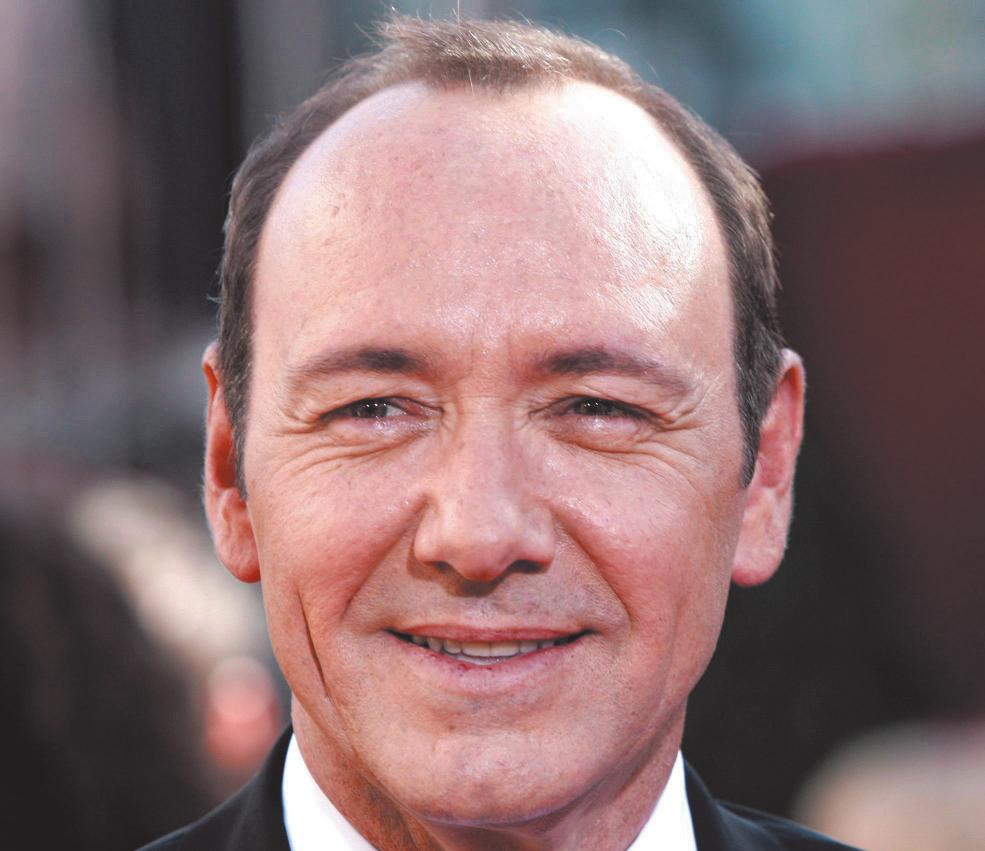
Spacey is now asking that he not be made to appear in court for his upcoming arraignment for sex assault charges.
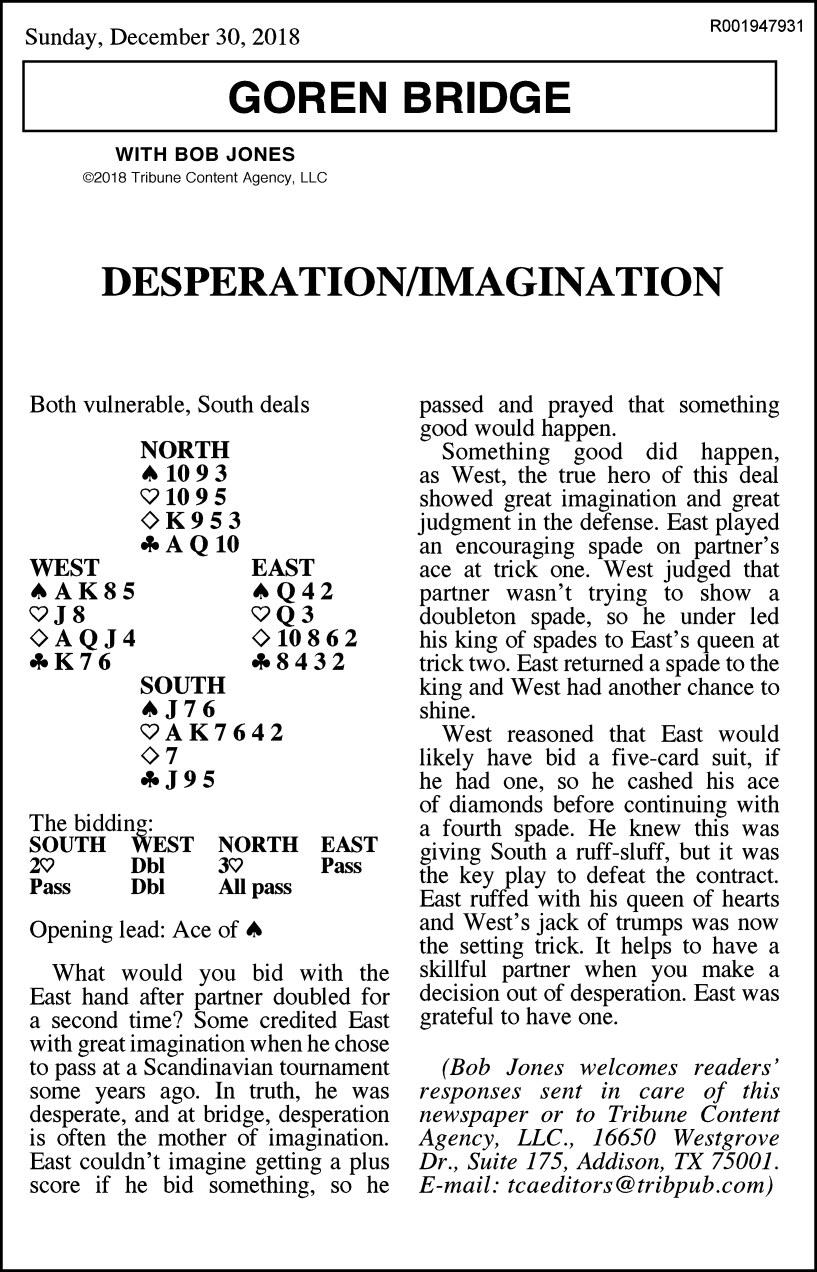
river. The title refers to a literal box of birds that her character carries – the birds begin to chirp when the unseen evil approaches. Like the timing of the final film, it seemed to be a fresh challenge.
“Anytime that they yelled ‘Stop!’ we knew we had gotten to a place where we could all get injured,” Bullock said. “And we fell. And I said don’t stop the camera unless I say, ‘Stop!”’
Citizen news service
BOSTON — Lawyers for Kevin
Spacey are asking a judge to allow the actor to skip his arraignment on sexual assault charges in a Massachusetts courthouse next month.
The Boston Globe reports that Spacey’s attorneys have filed a motion asking to excuse his presence at a Jan. 7 hearing in Nantucket District Court. The reason wasn’t disclosed.
Prosecutors asked the judge to deny the motion. The judge did not immediately rule.
Cape and Islands Assistant District Attorney Michael Giardino wrote that Spacey’s appearance is required under state rules for criminal case procedure.
The 59-year-old Oscar winner is charged with felony indecent assault and battery.
Prosecutors say he groped an 18-year-old man in a Nantucket restaurant in 2016.
Spacey’s attorneys have not spoken publicly about the case but in a court hearing questioned the evidence.




HEIGL
You knew 2018 was going to be an interesting year when it kicked off with a viral apology video from YouTube star Logan Paul, who said he was sorry for filming a dead body in Japan’s “suicide forest.”
As is tradition, there were quite a few apologies for mistakes that were offensive but also a bit more... well, bizarre. Here are some of the weirdest things celebrities apologized for this year:
• Posed for a goofy photo shoot in a cemetery.
Many of Katherine Heigl’s three million Instagram followers were not amused when she posted a series of silly photos and selfies from a cemetery in New York in June. After getting called out for being disrespectful, the actress removed the pictures and filmed two apology videos. She explained she was trying to find some “levity and humor” during a difficult day of visiting family members’ graves, but “didn’t realize how inappropriate I was being. I deeply apologize and I thank you guys for understanding that sometimes I don’t think things through clearly enough,” Heigl said.
• Joked about pregnancy news.
I’m so sorry for offending anyone – I hadn’t even put this together I was just excited to take a bath.
— Lorde
The Bachelor star Arie Luyendyk Jr. had a lot to apologize for in 2018, starting with his choice to break up with his chosen fiancee, Becca Kufrin, so he could propose to the runner-up, Lauren Burnham. But he really angered people on April Fools’ Day when he tweeted a photo of a baby bump: “Secrets finally out, we have a bunny in the oven!” When he revealed that it was a hilarious prank, fans eviscerated him and pointed out how many women can’t get pregnant.
“I do have sympathy for women struggling from infertility,” Luyendyk tweeted. “My April Fools prank was in no way meant to offend women who struggle with that. I apologize if you were (affected) personally by my post.” (Incidentally, he and Burnham recently revealed they’re expecting their first child.)
• Posted a bathtub photo captioned with Whitney Houston lyrics.
Getting ready to take a nice, relaxing bath one day in April, Lorde Instagrammed a picture of a tub and wrote, “And iiii will always love you.” It wasn’t the best caption, considering the singer of those lyrics, Whitney Houston, drowned in a bathtub. Commenters immediately pointed this out, and a mortified Lorde deleted the picture.
“Extremely extremely poorly chosen quote,” she wrote in an Instagram story. “I’m so sorry for offending anyone – I hadn’t even put this together I was just excited to take a bath.”
• Gave a far too candid interview to Vulture.
Quincy Jones’s Vulture Q&A in February was a wild ride, as the veteran producer talked about everything from his dates with Ivanka Trump to claims that Michael Jackson “stole a lot of songs.” It was one of the most-read stories on the Internet this year, but Jones expressed regret for his “word vomit” after a “surprise family intervention.”
“I’m so grateful for my daughters because they aren’t scared to stand up to their daddy,” he wrote in a statement. “I’m sorry & I’m not afraid to say it.”
• Tweeted rude comments during the Tony Awards.
Neil Patrick Harris, former Tony Awards host, watched the ceremony on TV in June and professed confusion about backstage commentator and Crazy Ex-Girlfriend star Rachel Bloom – even though you would think a musical fan would know the star of an acclaimed musical TV show.
“Who is the woman in the top hat backstage at @TheTonyAwards? Gideon remarked that she says ‘like’ and ‘oh my god’ a lot. I’m confused,” Harris tweeted. (Gideon is his eight-year-old son.) As fans wondered if he was serious, Bloom responded, “I’m a big fan of yours. We’ve met numerous times and my husband, Dan Gregor, wrote for How I Met Your Mother for 5 years.”
Awkward! Harris followed-up: “Sincere apologies to @Racheldoesstuff for my Tony tweet. I failed to research before pressing ‘send,’ and what I thought was a funny moment in our living room must have been far from funny to read, backstage, mid show.”
• Introduced a celebrity by the wrong last name. Ellen DeGeneres has known Channing Tatum and Jenna Dewan for years, and apparently their divorce was so amicable she forgot they split up. After DeGeneres introduced the actress as Jenna Dewan Tatum on her talk show in May, she corrected her mistake. “Before we go to break, I’m so sorry how I introduced you, it was just such a habit,” DeGeneres said. “I apologize ... I’m so used to saying it.” Dewan forgave her, and thanked everyone for their support.


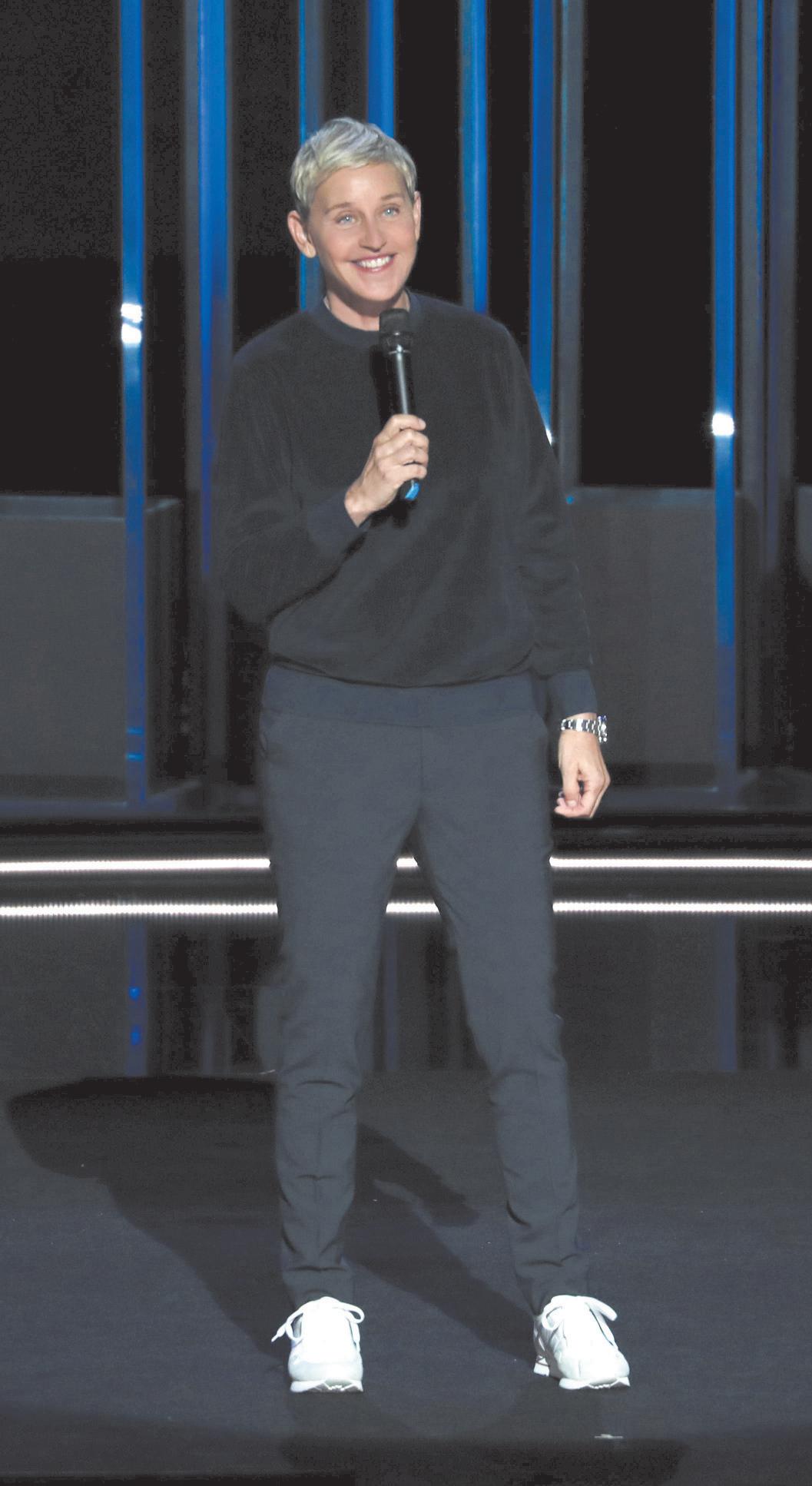
Elahe IZADI Citizen news service
What do you do when you’re already a multimillionaire daytime talk-show host beloved by legions? What challenge is left for you when you’re the person that celebrities and presidential hopefuls seek out? For Ellen DeGeneres, you go back to where you got your start. Netflix’s Relatable, which premiered last week, is her first stand-up special in 15 years. She joins several big-time comics (Chris Rock, Dave Chappelle) who have put out new specials after decade-or-more breaks.
Although being super-famous guarantees you’ll receive loads of attention and money in exchange for a new hour of material (especially with those multimillion-dollar Netflix payouts), fame can also create some weird dynamics for a comic. Audience members predisposed to thinking you’re wildly funny might either give you more leeway or hold impossible standards. But there’s one particularly distracting audience response that I’ve noticed in watching DeGeneres and comics of her caliber perform: the random, wild screaming.
Doing a stand-up special after a comic has grown wealthy and moved beyond stand-up itself has always brought creative challenges, especially when the performer’s thing is “did you ever notice” jokes. How can you still tell relatable quips about your life when your life is insane by normal-people standards?
“You know how in St. Barts,” asks 30 Rock’s Tracy Jordan, “people be eating their lobster like this?”
Instead of ignoring that conflict, DeGeneres makes it the premise of her special, as she delivers the same kind of observational humour that propelled her career decades ago while acknowledging her riches and making fun of herself (like when she mentions seat 10B on a plane. “Does a plane go back that far? I’ve never been back there.”)
Just as DeGeneres’ life has changed, so has her audience since her last special in 2003. Most people who watch her are now accustomed to seeing DeGeneres in her daytime environment, where the crowd audibly going bananas is part of the show. Some of that vibe is in her special; you can hear individual audience members scream as DeGeneres mentions giving away free stuff, a Sofia Vergara dandruff commercial and how she’s “still gay, by the way.”
It’s not just DeGeneres’ crowd, though; such behaviour during live comedy shows feels like it’s more common, from the yelling crowd that wouldn’t quiet down enough for Dave Chappelle to finish his infamous 2013 Oddball Festival set to the lone, intermittent screams during heard Trevor Noah’s 2018 special, Son of Patricia.
Perhaps we’re trained to respond this way because of the ubiquity of politically charged late-night jokes that spark constant cheering. Or maybe it’s just a symptom of culture evolving to be more participatory.
What’s the point of going to a museum exhibit if it’s not great on Instagram? Why simply watch a game show when you can play it with a million others? What’s so exciting about being an anonymous chuckle in a sea of laughter when you can be a solitary, long “wooo!” captured on a special, for everyone to hear forever? Laughing at a joke feels like a fave on Twitter; yelling during a joke is the equivalent of retweeting with a comment that simply reads “THIS” or “->.” Basically, it’s inserting yourself into a dialogue to signal agreement without providing any meaningful contribution.
In comedy, earning an applause break has long been accepted as a sign of a good joke; now it can feel like “I agree with the opinion within this joke.” There are way worse responses to comedy than genuine excitement: boos, heckling, silence when there should be laughter, talking when there should be silence. Still, shouting unintelligible “woos” as a comic sets up jokes can also be disruptive. Hannah Gadsby’s Nanette argued that comedy needs tension, as humour comes once it’s released. But what happens when there’s no tension at all?
A few audience members screaming as a comic performs takes us away from focusing on one person, and lessens the pressure that helps a joke succeed. There is a bigger audience for comedy than ever before, and some fans probably just want to feel like they’re at a raucous concert where they get to be a part of the show. Apparently being passively amused isn’t cathartic enough. But for the majority that isn’t screaming as a comedian performs, there’s no need to signal something greater to the world than offering laughter when a joke is funny, and silence when it isn’t.
Toronto marketing specialist
Elaina Falcone laughs as she thinks back to about a year ago when executives at her company started walking around the office having phone conversations on headsets, resembling drive-thru employees.
“I would be like, ‘Can I take your order?’ while walking by them,” recalls Falcone, who works at Accessible Media Inc., a notfor-profit media company aimed at Canadians who are blind or partially sighted.
“Literally imagine a McDonald’s worker with a little mouthpiece in the front.”
Such headsets are now omnipresent at the company and many others in Canada as more organizations get rid of their cumbersome, analogue desktop phones in favour of cloud-based and Voice over Internet Protocol (VoIP)-powered service on wireless devices.
The days of cranking one’s neck to the side to hold a receiver in place, and using up precious desk space with a bulky phone and spiral cord, are quickly fading as businesses switch over to VoIP and cloud-based providers like RingCentral and Microsoft’s Skype for Business.
Desk phones are also going the way of the dodo as more employees work from home or remotely, and companies replace assigned work stations with shared offices known as agile workspaces, where anyone can sit anywhere.
Many employees use laptops and smartphones and want that mobility and flexibility, says Falcone, noting it felt redundant having a personal cellphone, a work one and a desk phone.
According to an online survey of 400 small, medium and large companies released in July by IDC Canada, close to 90 per cent of Canadian firms have wireless phones and 49 per cent of their employees have substituted their landline phones entirely with wireless devices.
“It’s almost like the last resort is a paperweight, tethered desk phone,” says Lawrence Surtees, vice-president of communications research at IDC Canada, which does market research on information and communications technology.
“The non-smartphone is a dying thing.”
Surtees say smaller businesses in Canada went wireless earlier than larger ones, which are now making the switchover due to cost, convenience, increasing trust in cloud computing, and an overall rise in cord-cutting in daily life.
Saving money is another key reason companies say they’re making the switch.
That’s what happened when AMI added Skype for Business to its Microsoft Office 365 subscription, says Kevin Sharpen, who oversaw the project as manager of applica-
NEW YORK (AP) — Sears is closing 80 more stores as it teeters on the brink of liquidation.

tion development.
“We probably saved over 60 per cent of our phone costs,” says Sharpen, adding employees were able to keep the same work number.
“A lot of that is in long-distance costs, because on a regular phone system you’re paying long-distance. But when you’re talking on VoIP or a hybrid of that, those costs are significantly decreased.”
It’s also more financially feasible for organizations to run all of their communications through one interface that makes data more accessible and faster, says Rebeka Inoue, partner alliance manager AVI-SPL, a global workplace technology services provider.
“With the advent of the cloud, organizations were able to reduce a lot of overhead and expenses by moving everything into the cloud and having people like Microsoft manage that cloud and make sure it’s more secure than what most companies had on presence,” says Inoue, whose company transitioned to Skype for Business two years ago.
“We’re already paying for (Microsoft) licences, so it’s very inexpensive to just add on the Skype for Business licence.”
Sharpen says those with accessibility needs often prefer a system like Skype as it’s easier for them to use and they can incorporate it with special devices, like custommade headsets.
With Skype for Business, employees can integrate all of their Office products, record a call, notify others of their location and calendars, and collaborate through methods including video chat, instant messages and screen-sharing.
“It’s made the conversations or the meetings maybe a little bit more dynamic, because we have the option to share,” says Falcone.
For those who still prefer desk phones, some companies that have switched to VoIP systems still have a few of them kicking around, usually web-powered ones like those from Cisco.
Surtees says the wireless trend can only go so far, noting it would be hard for certain institutions such as those related to health care and government to go wireless.
“I could see hypothetically wireless substitution in business getting up around 75 per cent or so, maybe a little touch more,” says Surtees. “But I think it would hit a ceiling.”
Falcone says she loves the portability she now has and rarely gets work-related voicemails anymore, because she’s usually reachable on her cellphone.
But being so accessible can also feel like you’re taking your work home with you, she adds.
“Sometimes it will be 10 o’clock (p.m.) and I’ll see the little red ‘1’ on my work email or my Skype and I’m like, ‘Ugh,”’ Falcone says. “It makes it hard not to check.” Phone connections can also be weaker on a VoIP-powered service versus a landline. And some employees are slower to adopt the wireless system.
“People freaked out,” Falcone admits of the switchover. “They were used to the security of their desk phone. A lot of our older staff I think took it harder than others.
“The thing I still struggle with is like, ‘Where’s my headset to answer this phone?’ Just dumb stuff like that.
“But I have to say after a couple of months everyone adapted and there’s literally no difference now. The first couple of weeks we definitely had laughs of VPs having headsets on their heads and then that was it.”
What resignation letters can teach us about ourselves
Matt POTTER Citizen news service
The iconic retailer, once the United States’ largest department store chain, set a deadline of Friday for bids for its remaining stores to avert closing down completely.
The retailer that began out as a mail order catalogue in the 1880s has been in a slow death spiral, hobbled by the Great Recession and then overwhelmed by rivals both down the street and across the internet.
The 80 stores are due to close by March. That’s in addition to 182 stores already slated for closure, including 142 by the end of 2108 and 40 by February. The company filed for Chapter 11 bankruptcy protection in October , saying at the time it would close more than 20 per cent of all stores, keeping open only its 500 most profitable locations. Sears Holdings Corp., which also runs Kmart, joins the list of retail brands taken over by hedge funds that collapsed under the weight of debt forced upon them.

U.S. Defense Secretary James Mattis’s letter of resignation to President Donald Trump starts ominously, with a frosty disregard for White House form.
Lt. Gen. H.R. McMaster, in his letter resigning his post as national security adviser, was “thankful to President Donald J. Trump for the opportunity to serve him and our nation.” Even Attorney General Jeff Sessions, unceremoniously asked to resign, had managed an Apprentice-like “Thank you for the opportunity, Mr. President.”
But in Mattis’s letter, there’s a gaping hole.
“I have been privileged to serve as our country’s 26th Secretary of Defense which has allowed me to serve alongside our men and women of the Department in defense of our citizens and our ideals,” Mattis wrote, conspicuously avoiding any expression of delight, honour or gratitude toward the president.
And that’s just the opening.
“My views on treating allies with respect and also being clear-eyed about both malign actors and strategic competitors are strongly held and informed by over four decades of immersion in these issues,” Mattis wrote to a president whose decades have been informed by no such immersion. He continued, pointedly: “Because you have the right to have a Secretary of Defense whose views are better aligned with yours on these and other subjects, I believe it is right for me to step down from my position.”
The popular image of the big exit is a grandstanding, impromptu Jerry Maguire moment (“who’s coming with me?”).
Yet the most effective leave-takings are composed over time, and with military precision. These are made up of the words, distilled from private agonies, that we place on the public record. They must function as appeals to history and

our one good grenade. Planned, polished and executed for maximum effect, Dear Boss letters are ambushes by nature. The most famous – before Mattis – was that of the highly decorated Col. Millard Peck, who resigned in 1991 as head of the Pentagon intelligence unit assigned to search and account for MIA servicemen in Vietnam. Over four pages of complaints that would doubtless ring bells with Mattis, Peck wrote of being “painfully aware... that I was not really in charge of my own office, but was merely a figurehead or whipping boy for a larger and totally Machiavellian group of characters.” His department, he said, was nothing but “a toxic waste dump designed to bury the whole mess out of sight and mind in a facility with limited access to public scrutiny.”
He stapled the letter to his office door and strode away from his command.
In a country still ambivalent about remembering Vietnam at all, and haunted by the possibility of prisoners of war as well as those missing in action, the effect was electric. Within weeks, the Senate Foreign Relations Committee opened a public hearing. Peck ended up providing administrative services for military ceremonies. He’d taken the hit, but he’d got the result he wanted: a national public reckoning with the way the military looked after its own.
Mattis’s Dear Boss letter sits squarely in this military tradition. It is both a reckoning and a duty, at whatever cost. It may have been a surprise to us and, one must imagine, to Trump – no secretary of defense has ever resigned in protest before. Mattis’s letter is no simple insider hit. It could serve as a manifesto for his – perhaps even the president’s – successors. A vision of a still-possible future in which American security is better served in alliance and cooperation, not isolation, and, above all, a more unifying,
honest presidency. Just perhaps – and this has always been key to the Dear Boss tradition – it is Mattis showing Trump, pointedly, how leadership should be done, and what dignity and discretion look like.
Resignations are never just departures. They can spell the beginning of the end for seemingly invulnerable leaders whose autocratic tendencies or lack of restraint have become liabilities. Such was the case for British Prime Minister Margaret Thatcher. The resignation of a onceloyal senior official set her downfall in motion. And over the past three decades, Sir Geoffrey Howe’s resignation to her, like the Dear Boss letter, has become a template for diplomats and states-people alike, plundered as much as admired. Like Mattis, Howe, Thatcher’s deputy prime minister, was seen as the last moderating influence on an unpredictable and increasingly autocratic leader – a foreign policy expert, and the “grownup in the room.” Over the years, he had counselled diplomacy over confrontational rhetoric. His resignation in protest in November 1990 came at Thatcher out of left-field.
Reading his public letter of resignation to Parliament, he talked of how “every step forward risked being subverted by some casual comment or impulsive answer,” and compared serving under Thatcher’s leadership to being a sportsman who is sent out to play, only to find the moment they square up to hit the first ball, “that their bats have been broken before the game by the team captain.” Howe’s resignation ended: “The time has come for others to consider their own response to the tragic conflict of loyalties, with which I myself have wrestled for perhaps too long.” Sure enough, his resignation prompted a rush of such responses. Nine days later, Thatcher, the Conservative premier who had seemed so invulnerable, was gone.
Citizen news service
NEW YORK — Tesla named two independent board members Friday as part of a settlement with U.S. regulators who demanded more oversight of CEO Elon Musk. Oracle founder Larry Ellison and Kathleen Wilson-Thompson, an executive vice-president at Walgreens Boots Alliance, join the board as independent directors, effective immediately. Musk got into trouble with the Securities and Exchange Commission in August when he said in a tweet he had “funding secured” to take the electric car company private at $420 per share. The SEC accused Musk of committing securities fraud, saying the funding had not been secured and that he had duped investors. Several weeks later, Musk said the go-private deal was off.

Megan McDONOUGH Citizen news service
As 2018 comes to a close, home design experts already have some predictions for the new year.
The home remodeling and design platform Houzz recently released its annual forecast, derived from conversations with industry experts as well as trends spotted among its 40 million monthly users. It offers a snapshot of what we might see in stores, living rooms and Instagram feeds this year.
We chatted with Houzz editor and writer Mitchell Parker and asked him to dig into this year’s projections. So before you pick up that paintbrush, take a look at the colours and styles the pros say will be big in 2019.
• The backsplash as a focal point
In 2019, home design professionals expect to see more full-height backsplashes that seamlessly stretch from the counter to the ceiling – behind floating shelves and range hoods – for a clean and cohesive look. This dramatic statement can create the illusion of additional surface area.
• Dark and moody colours throughout the home
Although Living Coral may be Pantone’s pick for colour of the year, Houzz predicts homeowners will lean toward darker and moodier colours, such as navy and forest green, in the new year. Colour experts say it is a reaction to white and bright hues that dominated the design world for the past several years. Parker also suspects that visual social networks such as Houzz and Instagram may have helped people gradually become more comfortable with the idea of experimenting with richer and darker colours.
“If you tell somebody, ‘Paint your walls dark blue or black,’ people might imagine the Addams family house,” Parker said. But when they see a photo of the design and how these colours create a warm and serene setting, they are much more likely to have the confidence to try it.
• Destination tubs
Bubble bath fans, rejoice. As bathrooms shift from private, utilitarian spaces to open, spa-like environments, homeowners are focused on the accoutrements, including free-standing tubs. According to Houzz’s 2018 Bathroom Trends Study, 80 per cent of home remodelers were planning to upgrade their bathtubs. A soaking tub was the most popular option and received 69 per cent of the vote (a seven per cent boost from the 2017 findings).
To achieve the look, bath aficionados are “stealing space from hall and bedroom closets” to expand the size of the room, Parker says, and creating built-in nooks to keep the tub out of the footpath of the shower, sink and toilet.
• Tuxedo kitchens Although white kitchens have long reigned supreme, professionals are seeing a return to black in kitchen cabinets, range hoods and island accents. The colour can be edgy, chic and surprisingly practical for parents.
“If you’ve got a house with dogs and kids,

scuff marks on white kitchen cabinets are going to be a big problem. Black paint hides a lot more,” Parker says. Expect to see a lot more “tuxedo” kitchens contrasting black with white walls, backsplashes and marble countertops.
• Glass-and-steel room dividers
Thanks to the popularity of open floor plans, statement-making partitions will continue to flourish in the new year. Thin metal-and-glass doors and walls offer the illusion of open space while still providing privacy, light and noise mitigation. The dividers can also be used to add visual interest and provide definition to a room, without making it feel cramped or closed off.
• Free-standing dining benches
Custom, built-in benching, while popular and convenient, can be expensive. Homeowners are instead opting for padded furniture benches as an affordable alternative. The multifunctional pieces are great for small breakfast nooks, providing flexible seating and in some cases hidden storage.
• Board-and-batten accents
The modern farmhouse style will continue to flourish in 2018 and spread to the exterior of the home, Houzz experts say. The white siding delivers a “homey look” and can provide texture and interest to an otherwise flat facade.
• Kitchens that open to the outdoors
Fans of entertaining and cooking may want to consider expanding their kitchen area to the outdoors. Homeowners in warmer climates are transforming patios into extra seating areas, with durable rugs,

cushions and fabrics. Expect to see more kitchens completely open to decks and patios via collapsible doors and window walls in the coming year.
• Wood vanities
Houzz experts saw a resurgence of unpainted wooden vanities in 2018, and they predict it will only be amplified in 2019, with a turn toward reclaimed and light wood. Visible grain and knots can add texture and visual interest to a space and work well in crisp, clean white bathrooms.
• A four-wall accent colour
Forget the accent wall; 2019 is all about the accent room. Instead of a bold-coloured feature wall, homeowners are opting to paint all the walls – even the trim and moulding – in one room a dramatic and bold colour.
“Typically, I see this trend happening in smaller, somewhat private rooms, such as bedrooms, home offices, studies and media rooms – places where you want a comforting and relaxing vibe,” Parker says.
Popular colour choices include navy and forest green.





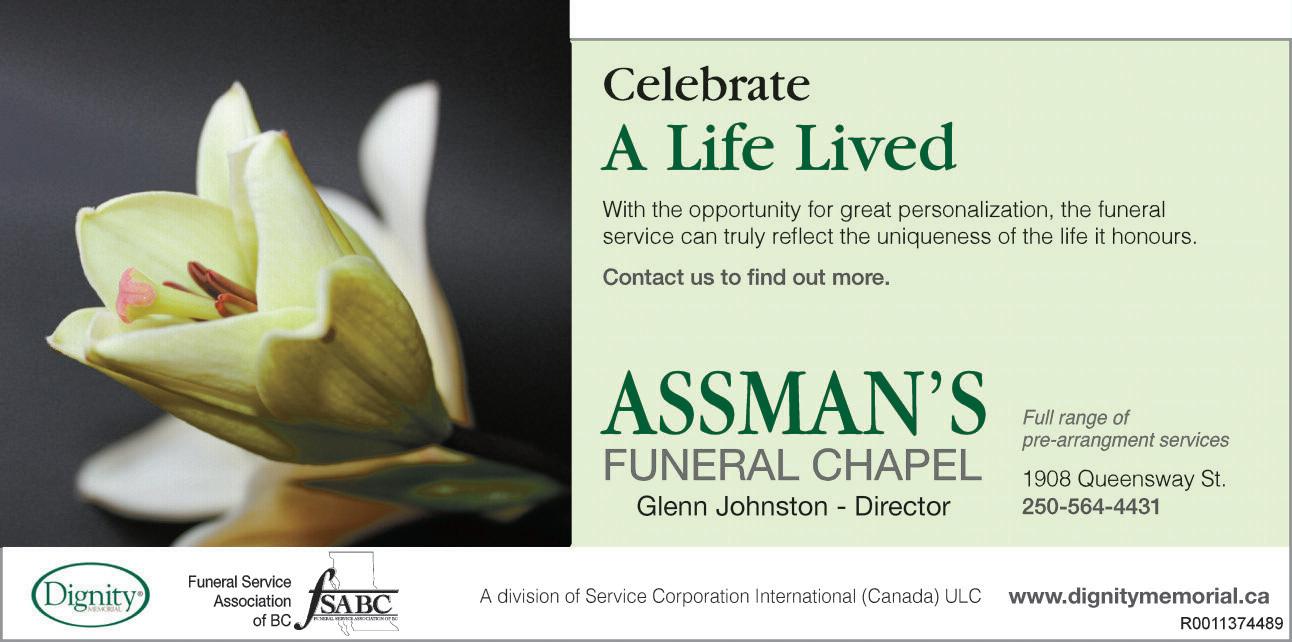


William Joseph Gardiner May 24th 1952 - December 20th, 2018
It is with profound sadness that Bill’s family announce his sudden passing in Prince George. Bill was born in Vancouver and raised in North Vancouver and later spent most of his life in Prince George. With a broken heart Bill will be sadly missed by his loving wife of 22 years Wendy. Survived by Mother Flora, son’s Matthew, Joshua, stepson Tyler, sister Carol, (Den) Granddaughter Eden.(Predeceased by his father Hank and Stepson Travis) and so many more friends and family. Bill proudly served with the P.G. Fire department where he retired as a Captain after 34 years. Bill (Billy) was admired and respected amongst his fellow firefighters and all those who knew him. Bill was well known in his high school years as a high ranking scoring guard in basketball, but Bill’s real passion was golfing. He was a member of the PGGCC & IAFF Alumni. Bill will be truly missed and there will never be a day that we all don’t think of him with love.
Rest in peace my love. We will one day be together again. Love you with all my heart ~Wendy~ Celebration of life to be announced at a later date.
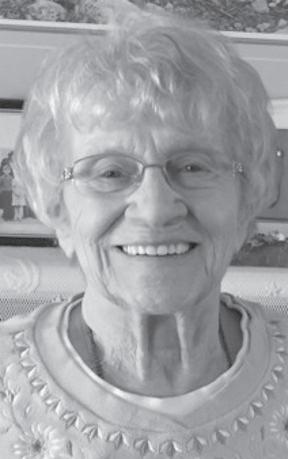

Eric “Rick” Rupert Love passed away on December 22, 2018 at the age of 96.
Survived by his loving daughter Jill Love of Vancouver and son Bruce (Maria) Love of Prince George. Predeceased by his beloved wife Kathleen “Kit” Love. We want to thank Fiki, Eyob and the staff of Enat Complex Care for the wonderful care they took of our father.
We miss you Dad Celebration of Life to be held at a later date.
Linda Margaret Ormiston
August 26, 1943December 20, 2018
Flo Comtois October 21, 1931December 24, 2018
Flo passed away peacefully at home, while surrounded by her loved ones, after a short but courageous battle with cancer. Flo will be sadly missed and lovingly remembered by her 4 children: Marnie (Don) Rahn, Sue Lorrie, Debbie (Tim) Taylor, & Ray (Debbie) Comtois. Her 6 grandchildren: Tanya (Bob) Kallis, Shawna Lorrie (Dave Oliver), Tom Lorrie, Michael (Julie) Gagnon, Patricia Wheeler (Tate Wright), & Holly (James) Jacklin. Her 12 great grandchildren: Jaida, Julian, Kaitlyn & Kaeden Kallis, Morgan Wade, Julia, Mikaela & Mackenzie Gagnon, Taylor & Tyler Wheeler, and Bryanna & Dylan Jacklin. Flo was predeceased by her loving husband Leo Comtois & her parents Blanche & Frank Parker. Flo is survived by her sister Gloria Ferguson, and her brothers Frank, Ron, Larry & Don Parker, and many nieces and nephews. Flo will be fondly remembered by many long-time friends. We will all miss Flo’s easy laugh, friendly smile and bear hugs - she will be remembered with love. Flo moved to Prince George in 1968, from Ontario and took a job as Manager at Sweet 16 in Spruceland Shopping Centre before moving to the downtown location on 3rd Avenue. Flo later worked with Leo in their own businesses - Spruceland Realty and Favor Homes. The family wishes to extend thanks to Dr Inban Reddy, and to the wonderful home nursing staff. In lieu of flowers, donations would be greatly appreciated to St Vincent de Paul Society. A Celebration of Life will be held at a later date.

It is with heavy hearts that we announce the sudden passing of our amazing mother, grandmother and friend, Linda. Mom was predeceased by our father, John, earlier this year. She is survived by her daughters, Donna (Doug) and Debbie and grandchildren, Mandy (Adam) and Steven. Mom had her share of health issues these past few years but she wasn’t one to complain.
Mom will not only be missed by her family, but by all those who knew her. We would like to thank Drs. Neary and Preston for their care of Mom. In keeping with her wishes, there will be no service. In lieu of flowers, please consider a donation to the BC Lung Association or the BC SPCA.
Rest In Peace Mom. You may be gone but you will never be forgotten.
Phyllis Pauline Kennedy

Born September 6, 1936 in Spearman, Texas, passed peacefully December 23, 2018. We announce with deep sadness that Phyllis has left us to join her husband of 58 wonderful years Stanley Eugene Kennedy who passed December 13, 2016. Phyllis was very colorful and vibrant with a large network of personal relationships and close friends around the world. She was a memorable person who’s influence’s and attention to detail made ordinary things into special events. Phyllis was survived by her sister Barbara, brothers Wayne and Trent and children Sherry, Paul, Rex, Linda and Roy Allen as well as grandchildren and great grandchildren. It comfort’s us to know that Stan and Phyllis will once again be graceful soulmates of the dance floor in Heaven. In lieu of flowers please donate to the Salvation Army.


































































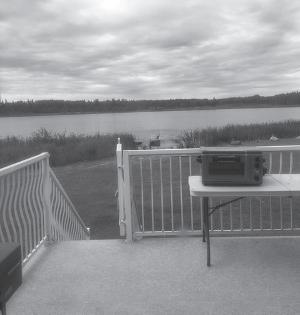









Currencies
OTTAWA (CP) —
Laura KANE Citizen news service
VANCOUVER — A licensed marijuana store is set to open in Vancouver as the number of legal pot shops in British Columbia still lags behind other provinces.
Evergreen Cannabis owner Mike Babins said the store received its provincial licence this week and plans to open its doors on Jan. 5, a few days later than he originally intended.
As long as it receives a municipal licence, it will be the first legal store in the city since recreational cannabis was legalized on Oct. 17.
Babins said the provincial licensing process was “extremely, extremely thorough.”
“They worked really, really, really hard to make sure there’s no organized crime in this industry,” he said.
“They went back 20 years with me and my wife to find out every job we’ve had, every vacation we’ve taken.”
The markets today
TORONTO (CP) — Canada’s main stock index posted a second day of gains Friday to end the week higher while U.S. markets were mixed.
The S&P/TSX composite index closed up 56.79 points at 14,222.00 to register a 286.56-point gain in a shortened holiday week marked by volatility. The gains came after several weeks of losses that had likely gone too far, said Cavan Yie, a portfolio manager at Manulife Asset Management.
“Today you’re seeing sectors that have been oversold over the last several weeks bouncing back. So in the Canadian market I’m seeing industrials and energy finally leading the strength. And obviously these are two sectors that have suffered a great deal over the last several weeks.”
The S&P/TSX capped energy index climbed 3.16 per cent on the day, which followed on a 5.57 per cent gain a day earlier. The energy sector has moved up faster than the price of oil, with the February crude contract climbing 72 cents to US$45.33 per barrel Friday, but Yie said he expects oil to climb further.
“Producers can’t make a return at these levels, most aren’t free cash-flow positive at these levels. So our view is that supply has to come down with oil below 50 and should translate into a more normalized supplydemand environment, which could take some time.”
The health-care index was the only one to top energy after Aphria Inc. shares climbed more than 12 per cent on news of a hostile all-stock takeover bid from U.S.-based Green Growth Brands.
In New York, the Dow Jones industrial average closed down 76.42 points at 23,062.40. The S&P 500 index ended down 3.09 points at 2,485.74, while the Nasdaq composite was up 5.03 points at 6,584.52. Markets were somewhat subdued Friday, but have been hit in recent weeks by an uncertain interest rate outlook, China-U.S. trade relations, and the possibility of a cyclical peak, said Yie.
“All three factors have contributed to the last month’s market correction,” he said.
The Canadian dollar averaged 73.32 cents US, up 0.01 of a US cent from Thursday. The February natural gas contract closed down 24 cents at US$3.30 per mmBTU. The February gold contract closed up $1.90 at US$1,283, and the March copper contract ended up a penny at US$2.68 per pound.
The store co-founded by Babins and his wife Maria Petrucci in the city’s Kitsilano neighbourhood originally opened as a medical marijuana dispensary in September 2015. It operated for three years with a municipal licence under the city’s old licensing regime.
The couple shut the store’s doors on Oct. 16 while they waited for provincial approval to reopen as a recreational weed shop.
A number of illegal dispensaries remain open in Vancouver despite a court order this month affirming the city’s authority to shut them down.
The approval of Evergreen brings the total number of licensed marijuana shops in B.C. to five, with the others in Kamloops, Kimberley and Pouce Coupe.
Provincial government websites list 65 licensed pot retailers in Alberta and 20 in New Brunswick, while Ontario will not have any stores until April.
B.C. Public Safety Minister Mike Farnworth has defended the province’s pace on pot shops, saying the government gave more of a voice to municipalities than others.
Babins said he believes B.C. licensing officials are working hard and he understands why it’s taking so long to licence stores.
“Having seen what the process is, I completely understand now,” he said.

The couple paid taxes from Day 1, tracked everything they purchased and never borrowed money, instead using retirement savings to open the store, he said. They also hired a lawyer and consulting firm to help with the application.
“We did everything right. We made it easy for them and it still took this long because they had to check to make sure we were squeaky clean.”
They applied for a provincial licence in mid-August and finally received it on Tuesday.
The store still requires a new municipal licence to operate legally.
Babins said the city has signalled its support of the store but no one is available over the holidays to
issue their licence, so the couple plans to be at city hall first thing on Tuesday.
While he initially planned to open today, Babins said the order he placed with the BC Cannabis Store to supply the shop didn’t go through because municipal approvals were not in place.
“Unfortunately the system is set up in a way that without certain paperwork put in the system, it won’t open the portal for us to make the order,” he said.
“We’re not taking it as a step back. We’ve followed the rules from Day 1 and we’re not going to start breaking them now.”
Although shortages persist across the country and many items on the BC Cannabis Store are listed as “limited quantity,” Babins
said he anticipates having enough supply. His goal is to have 20 different strains on site at all times.
Asked what he expects from customers when the store opens, Babins described Kitsilano as “ground zero for legalization of cannabis since the 1960s.”
“We have a large amount of old hippies who have been waiting for this day a very long time. We’re right near UBC, so we have a large amount of students who’ve been waiting for this day a long time,” he said with a laugh.
“Then there’s all the middleaged couples, the parents, the soccer moms, who are so glad the stigma is finally up. ... And I’m assuming there are going to be a lot of people who are just curious, too.”
Ian BICKIS Citizen news service
Mills in the heart of Canada’s timber industry have fallen quieter this winter as wildfires and infestations made worse by climate change have made vast tracts of once valuable forest into barren stands of dead trees.
After seeing record high softwood lumber prices earlier this year, Canada’s forestry industry is facing an uncertain future due to falling demand from a cooling U.S. housing market, increasingly frequent and intense forest fires and the continuing damage from pests such as the mountain pine beetle.
“We’re kind of at that point in the cycle where, unfortunately, permanent reductions have to happen,” said Ed Sustar, a forestry products analyst at Moody’s Investor Service.
“It’s going to be a relatively sizable part of the B.C. lumber industry, but it’s not a surprise.”
British Columbia, home to close to a third of Canada’s wood manufacturing jobs, is showing the most visible effects of reduced supplies as numerous companies have cut back mill production in recent months.
West Fraser Timber Co. Ltd. cited timber supply shortages brought on by the mountain pine beetle for permanently cutting 300 million board feet of production, at a cost of upwards of 75 jobs in the new year, at its Fraser Lake and Quesnel sawmills. That was on top of production cuts in the last stretch of the
year at a string of interior mills from log supply constraints.
Interfor Corp. cut about 20 per cent of production for this last quarter, citing escalating log costs, while Canfor Corp. curtailed B.C. production by 10 per cent due to log supply constraints. Conifex Timber Inc. cut production by 15 per cent at its Fort St. James, and then by another 10 per cent for the next half year.
The supply issue has, however, been looming for some time, as the large swaths of B.C. forest killed by a pine beetle epidemic decay into worthless dead stands.
The tinderbox created by the outbreak, combined with warmer, drier weather, have in turn helped create back-to-back record forest fire seasons in the province.
In 2017 wildfires destroyed about 1.2 million hectares of forest. This fiscal year it’s estimated at 1.4 million, compared with an average of 151,000 hectares for the 10 prior years.
The decrease in the amount of healthy B.C. forest has pushed companies to expand further into the U.S. or abroad, said Sustar.
“All these companies where B.C. was their base, they’re all expanding and diversifying outside of B.C., and B.C.’s become a smaller portion.”
The provincially-set amount of timber that industry can harvest has already dropped by about 25 per cent in the past decade to around 52 million cubic metres, noted Sustar. B.C.

government projections on the impacts of the 2017 fires alone are expected to reduce the mid-term supply by more than half in Williams Lake and 100 Mile House and by about 44 per cent in Quesnel.
“We do and we will have a mid-term challenge with respect to availability,” said Susan Yurkovich, president of the B.C. Council of Forest Industries.
“Fibre availability is a key issue for the industry, it’s our main product input, so of course it’s very significant.”
The wild card in all of this continues to be the effects of climate change, and how much it will change the supply picture.
“It’s already really created huge problems in terms of timber supply,” said Sally Aitken, a professor at the University of British Columbia.
“Climate change will touch pretty much everything we do in forestry, and everything that lives in forests.”
She’s studying how to create forests that will be more resilient to climate change, by selecting genetic varieties of trees that could better withstand the changes coming.
The impact of climate change on the health of forests is hard to predict, however, as changing weather patterns lead to both wetter and drier conditions, while a variety of threats including insects like the pine beetle, fir beetle, spruce budworm as well as diseases and fungi get worse.
“Many a small thing has been made large by the right kind of advertising.” — Mark Twain Call 250-562-2441 to go large
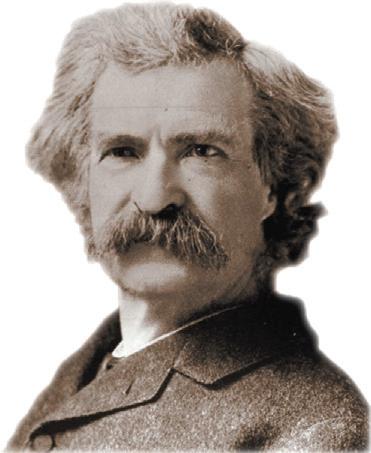
Matt SCHUDEL Citizen news service
Sister Wendy Beckett, a Catholic nun who left her cloistered life in the British countryside to become an unlikely international celebrity by presenting television programs on art history, died Dec. 26 at a residential care facility near Quidenham, England, where she lived on the grounds of a Carmelite monastery. She was 88.
A spokeswoman for the monastery, Gina Rozner, confirmed the death. The cause was not disclosed. Sister Wendy had a history of heart ailments and strokes.
Sister Wendy retreated to a life of seclusion in 1970, officially designated a consecrated virgin by the Catholic Church. She lived alone in a trailer, spending seven hours a day in prayer and translating Latin religious tracts.
After receiving permission from the church, Sister Wendy began to study art history, primarily through books and reproductions on post cards. She began to write for magazines and in 1988 published the first of more than 30 books, Contemporary Women Artists.
In 1991, she appeared in a BBC documentary about the National Gallery in London, discussing the paintings of Rembrandt. Although she was on-screen for only four minutes, viewers were transfixed by the bucktoothed nun in full religious habit and oversized glasses, speaking with wit, warmth – and a slight speech impediment – about one of the greatest artists in history. She soon became the host of her own BBC show, Sister Wendy’s Odyssey, a series of 10-minute segments in which she described various works of art.
At the beginning, Sister Wendy was shown emerging from her book-filled trailer, as if making her first forays into the wider world of art – which, in large measure, was true.
She proved to be charming and at ease in front of the camera.
Always speaking without a script, she became known to her producers as “one-take Wendy.” With her expressive face and hands, she described art with a mixture of glee, ecstasy and wonder.
“I force myself to look at it, take it in and tell you in words what I have seen, which is not an easy thing to do because it means going deep into your reactions,” she
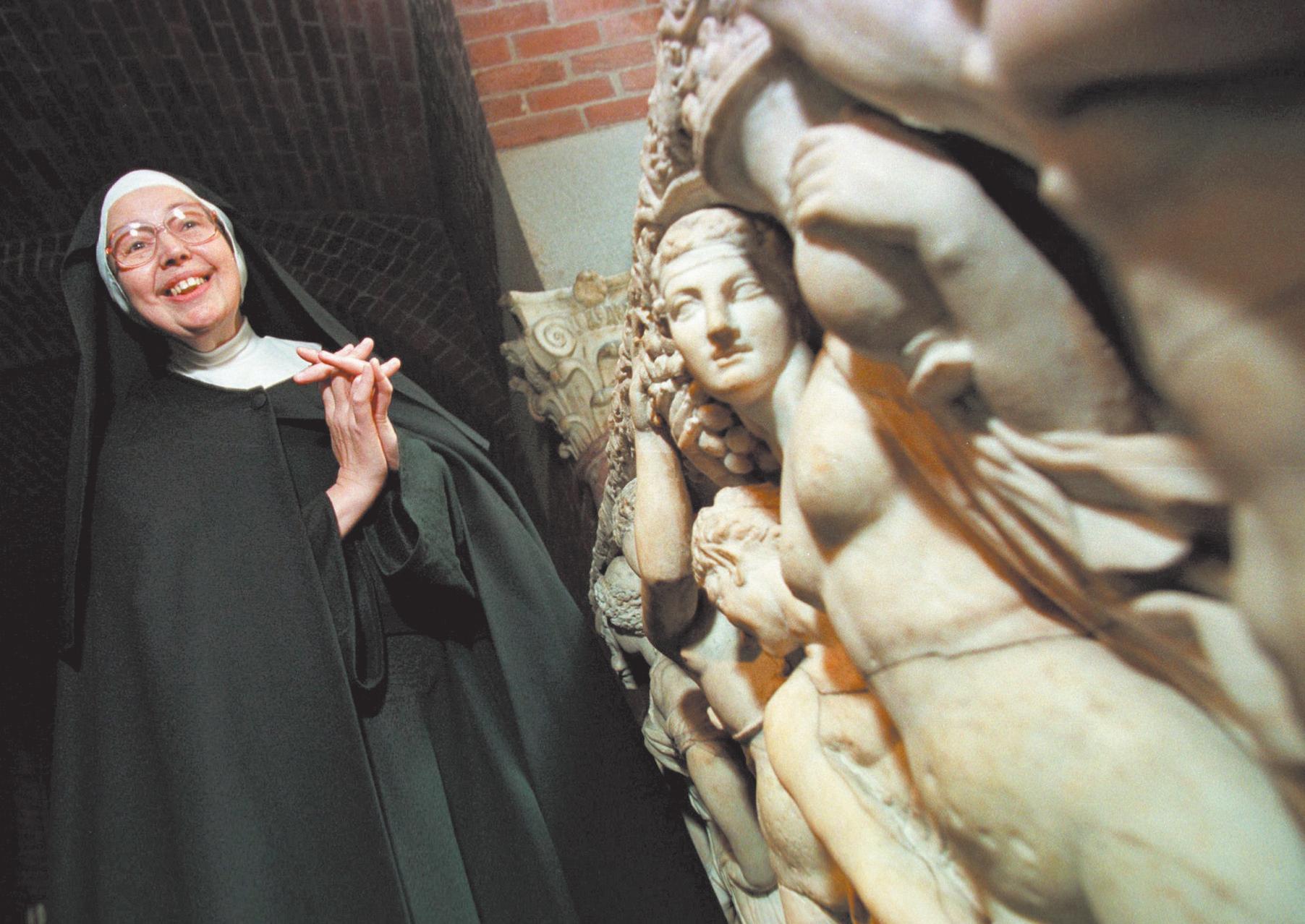
told the New York Times in 1997.
“I can’t do anything without the work of art being there to draw it out of me.”
For her second series, Sister Wendy’s Grand Tour (1994), she made her first trip to continental Europe, visiting museums in Paris, Rome, Amsterdam, Madrid, Florence and Berlin. (By then, she had an agent who substantially raised her fee and negotiated a clause that allowed her to attend mass every day.)
Sister Wendy became a media sensation, and her two series were the most successful arts programs on British television since Kenneth Clark’s Civilisation in the late 1960s. They often attracted a quarter of the British TV audience.
Many viewers found her programs inspiring, but some were shocked by Sister Wendy’s enthusiastic appreciation of the carnal nature of many artworks, including her oft-repeated description of a nude couple: “I love all those glistening strands of his hair, and her pubic hair is so soft and fluffy.”
She answered the objections with a stern rebuke based on her reading of scripture.
“I’m absolutely astonished and bewildered to find people commenting on my delight in a naked body,” she told The Washington Post in 1997. “Never, ever, has
Sister Wendy became a media sensation, and her two series were the most successful arts programs on British television since Kenneth Clark’s Civilisation in the late 1960s.
anyone suggested that parts of the body were not quite right, that God made a mistake, that they should be passed over. It’s appropriate to comment on everything in the painting. I’m not going to deny God’s glory by pandering to narrow-mindedness.”
In 1994, Sister Wendy published The Story of Painting, a coffeetable book examining more than 200 paintings throughout history. It formed the basis of her most ambitious TV series, Sister Wendy’s Story of Painting, which appeared on the BBC in 1996 and on PBS stations in the United States a year later. For the 10-part series, she visited 12 countries and traveled more than 50,000 kilometres to chronicle painting from prehistoric times to Picasso.
She brought a distinctly 20th century interpretation to the work of 14th century painter Giotto –“my dear, dear Giotto” – whose paintings led the way to the Renaissance.
“Think of how dark it was outside without him, as if everyone was listening to the radio,” she said. “And suddenly he comes forward and it is, yes, like the coming of television. Suddenly people have this great colour. This television.”
Explaining how the work of the tortured Vincent van Gogh resonates so strongly with people more than a century after his death, Sister Wendy said, “we are an anxious, neurotic generation, and we warm to this neurotic man, struggling so bravely to impose calm upon the turmoil of his mental stresses.”
She had an appreciation of abstract art, but she clearly preferred traditional figurative works. Her favorite artists included 17th century Spaniard Diego Velázquez –“the greatest painter the world has ever seen” – 19th century French painter Paul Cézanne and her British contemporary, Lucian Freud, who often portrayed people in fleshy, unflattering poses. Sister Wendy was seldom overt-
Michael E. RUANE Citizen news service
On Christmas Eve in 1818, two men with a small guitar entered a church in Oberndorf, Austria, and prepared to sing a new Christmas carol. Times had been bad in Oberndorf, where many people worked on the water, manning the salt barges that plied the Salzach River. The upheaval in central Europe caused by the Napoleonic Wars had just ended.
And only two years before, the dreadfully dark summer of 1816 – later blamed on ash from a volcanic eruption in Indonesia – had caused famine and deprivation.
But in that fall of 1816, a young Catholic priest, Joseph Mohr, had written a six-verse Christmas poem that began Stille Nacht, Heilige Nacht – Silent Night, Holy Night –about the Nativity of a curly-haired Jesus. Two years later, Father Mohr enlisted a friend, Franz Xaver Gruber, a local schoolteacher and musician, to come up with a melody for the poem that could be played for Christmas on the guitar. (Legend has it that the church organ had been damaged by mice or water and was on the blink.)
Gruber’s composition is thought to have taken about a day.
As the two men put the words to music that Thursday 200 years ago in Oberndorf’s St. Nicholas Church, they voiced for the first time what has probably become history’s most enduring and beloved Christmas carol.
Silent night, holy night
All is calm, all is bright...
“It’s such a part of the general soundscape of Christmas,” said Sarah Eyerly, assistant professor of musicology and director of the early music program at Florida State University’s College of Music.
“Oftentimes when songs are composed by people in times of great stress, there’s something quite human about them,” she said. “And that often resonates with people outside of that particular geographic location, or culture or time period.”
Since 1818, Silent Night has been translated from German into hundreds of languages. There are about a dozen different translations just in English, with an 1850s version the most widely accepted, Eyerly said.
The carol has spawned TV shows, a cartoon, a documentary. On the Western Front
in 1914, during the First World War, it was sung during the spontaneous Christmas Truce between allied and German soldiers who had been slaughtering each other hours before.
It’s been performed by rap musicians, Bing Crosby and the Mormon Tabernacle Choir.
There are gospel and heavy metal versions.
Yet it is the intimacy of the words, the scene and the music for the small parlour guitar that has soothed listeners for two centuries.
“Mohr was a guitarist,” Eyerly said. “Guitar is a much more approachable folk instrument than an organ, and for a song in this style... it would be much more common to play it on a plucked string instrument like a guitar.”
The two men probably sang it as a duet, with Mohr playing, a la Simon and Garfunkel, who did a haunting version in 1966, called 7 O’Clock News/Silent Night. In that version, the carol is sung to the piano over the background of a grim 1960s newscast. Why Mohr didn’t just write the melody himself is a mystery.
ly critical of any artists, although she cared little for the work of Spanish surrealist Salvador Dalí or the “really pathetic” modern British artist Damien Hirst, who sometimes put dead animals on display in containers of formaldehyde. She developed a devoted following among ordinary readers and viewers, who stopped her on the street whenever she was out in public. But professional critics often dismissed her as an untutored interloper who didn’t understand modern trends in art or critical theory. Time magazine’s Robert Hughes – the host of several competing television programs on art history – mocked her as a “relentlessly chatty pseudo-hermit with her signature teeth” whose observations were “pitched at a 15-year-old level.”
Sister Wendy said she deliberately ignored the jargon of the art world in an effort to make her presentations more accessible.
“I’m not a critic. I’m an appreciator,” she said in 1999. “I think great art opens us not just to the truth as an artist sees it, but to our own truth... You’re being invited to enter into the reality of what it means to be human.”
Wendy Mary Beckett was born Feb. 25, 1930, in Johannesburg, South Africa. She soon moved with her family to Edinburgh, Scotland, where her father studied medicine. The family later returned to South Africa.
Sister Wendy read constantly as a child and entered religious life in 1946. She joined the Sisters of Notre Dame de Namur, a teaching order, and studied English literature at the University of Oxford, graduating in 1953 with highest honours. One of her professors was Lord of the Rings author J.R.R. Tolkien.
At Oxford, Sister Wendy maintained a vow of silence, living in a religious community and rarely speaking with her classmates. She taught in schools in South Africa from 1954 to 1970, when she began to suffer from epilepsy. She was released from her order and lived by herself at a Carmelite monastery in northern England for the rest of her life, although she was not a member of that order. Her final TV series, a tour of U.S. museums, appeared in 2001. She continued to write books, including works on art history, Catholic saints and personal meditations, until 2011. She donated all her earnings to the monastery where she lived – a monastery without a television.
“He was a really gifted violinist and guitarist,” Eyerly said.
But Gruber chose a special musical style, called Siciliana, for the melody, she said.
“It’s an Italian song form that was really popular in the 17th and 18th centuries. It’s meant to mimic the sound of water. It’s associated with gondoliers in Venice, or Italian fishermen... (But) why that style?”
“I really think that it’s because most of the congregation that were listening that evening were workers on the river,” she added. “They were either ship captains or ship workers... I can’t prove this, but this is my analysis of the piece... that it mirrored the soundscape of water and it links to people’s daily lives.”
The carol spread quickly across Europe. It was bought to the United States, where, some accounts say, it was first performed on Christmas Day, 1839, in the churchyard of New York’s Trinity Church, Wall Street, by a troupe of traveling Austrians, the Ranier Singers.
The carol was translated into English in the 1850s by an Episcopal priest at Trinity, John Freeman Young. He published it in a book of Christmas carols in 1859.
